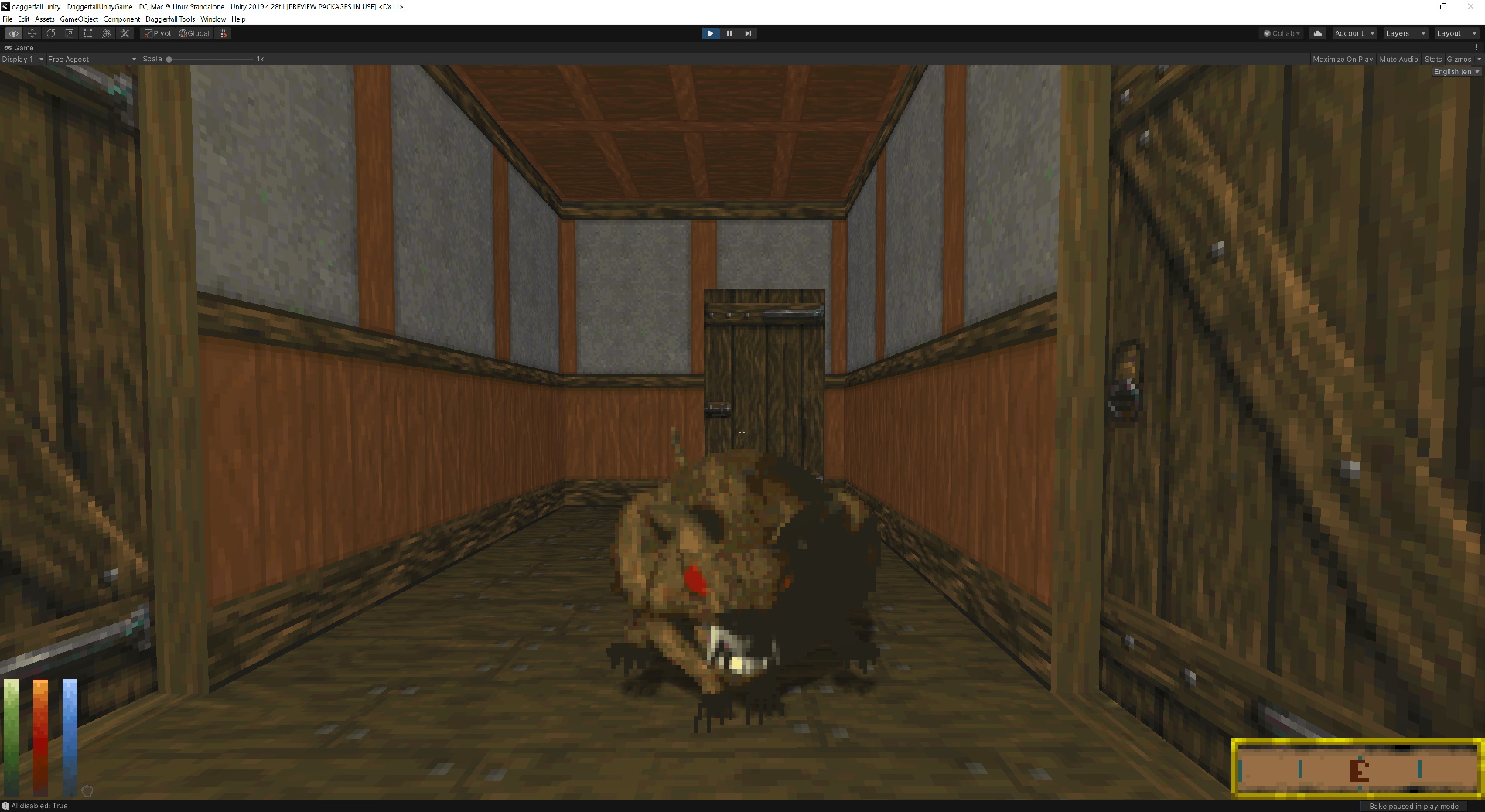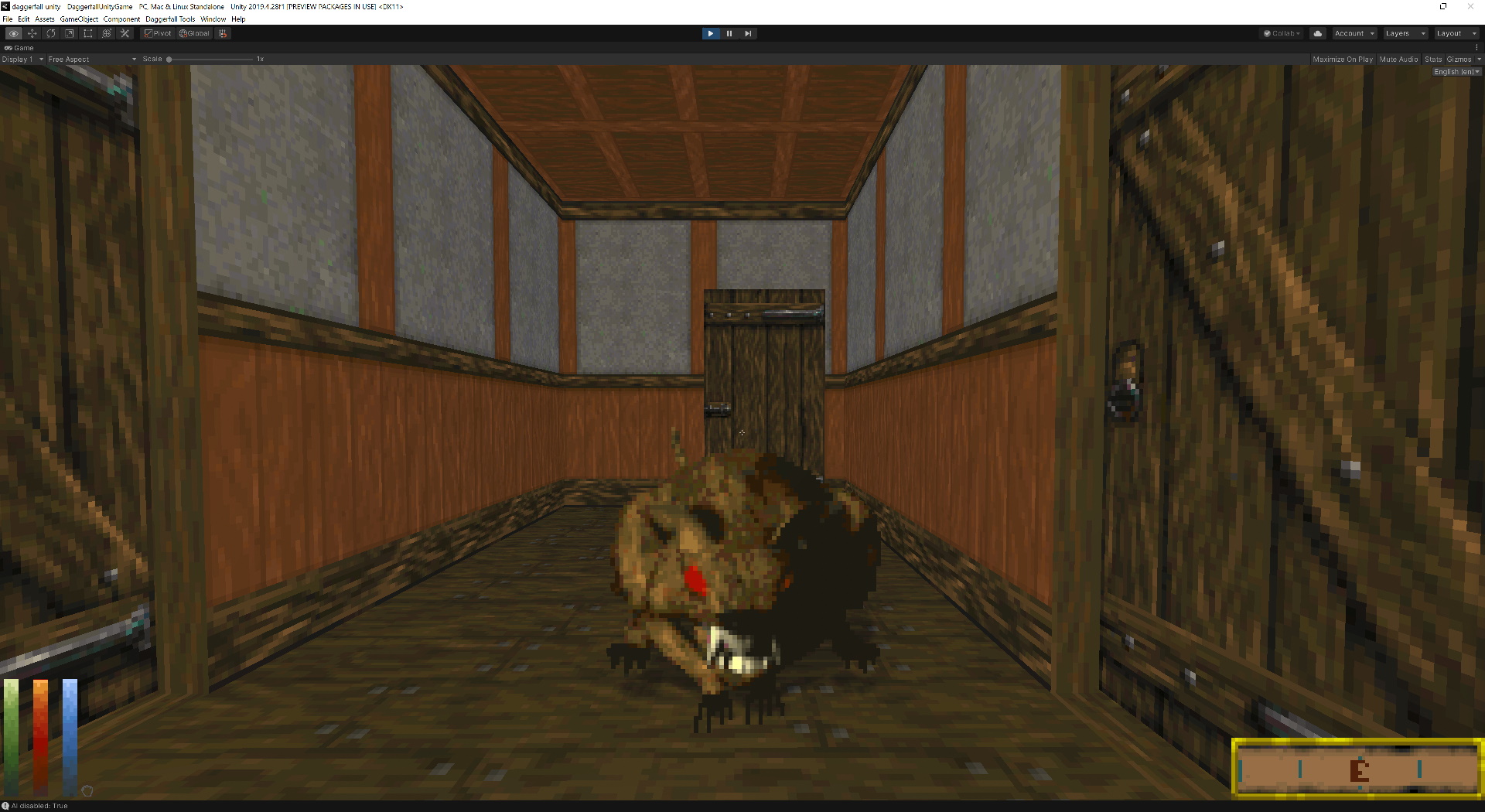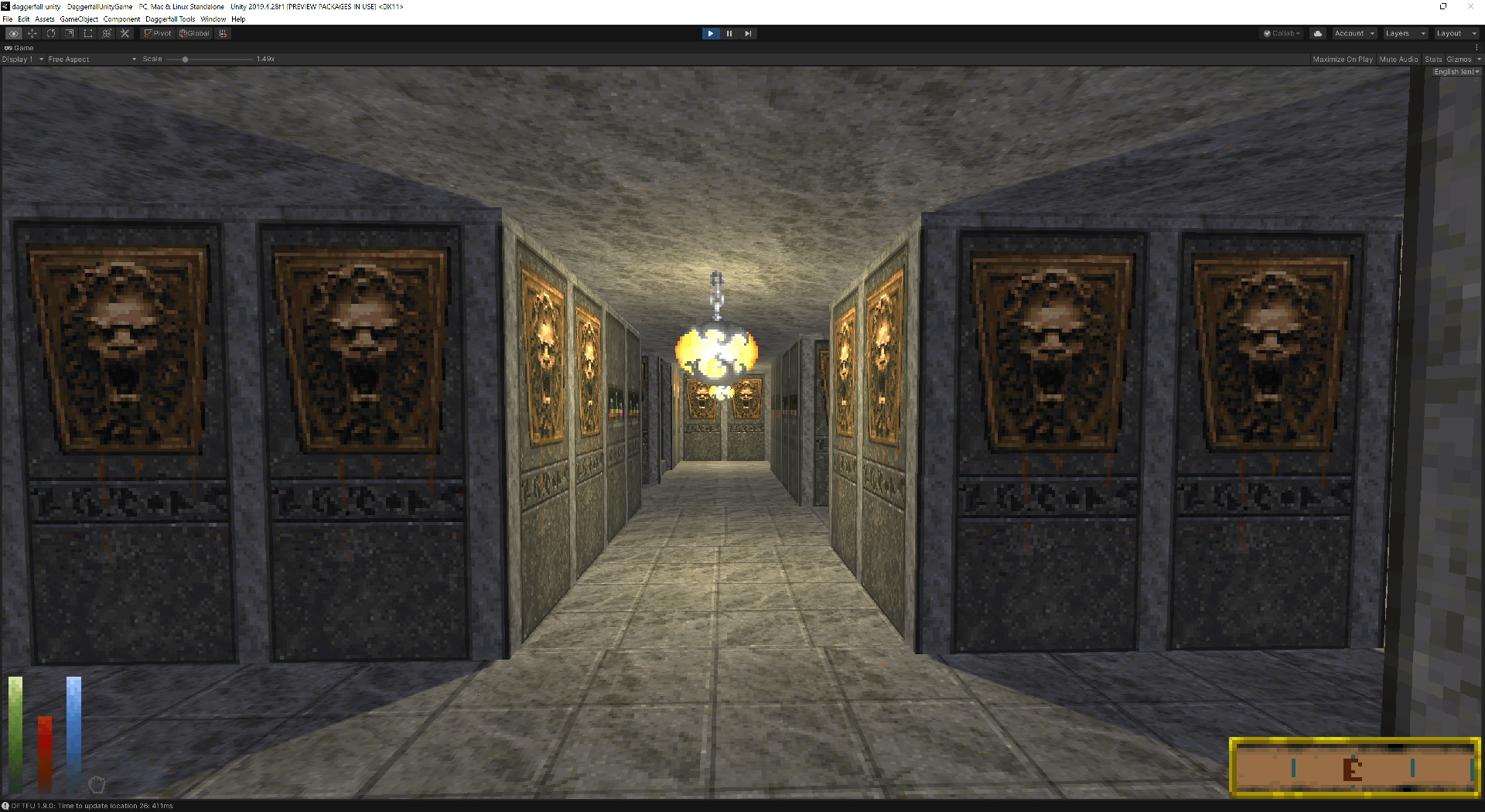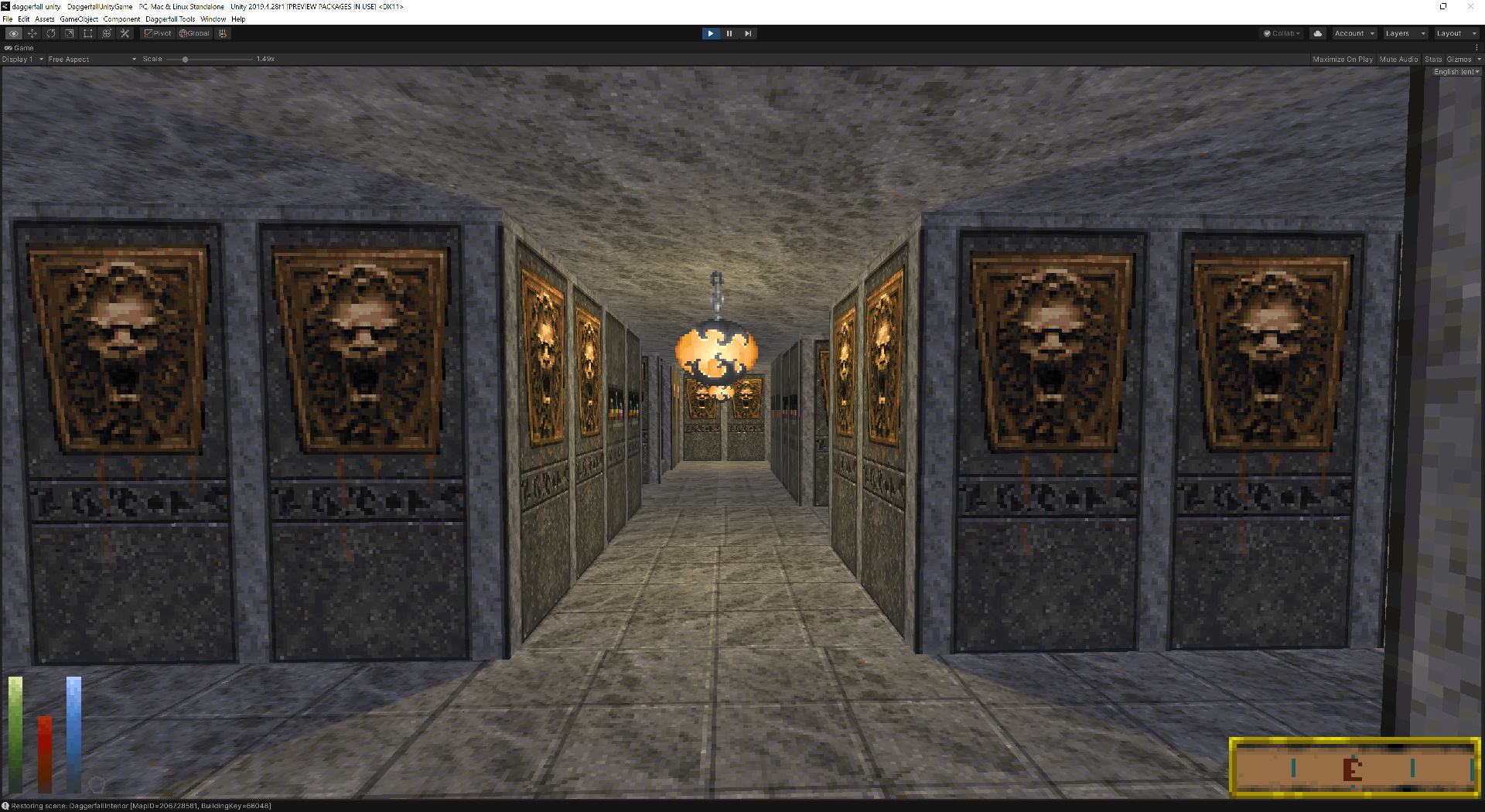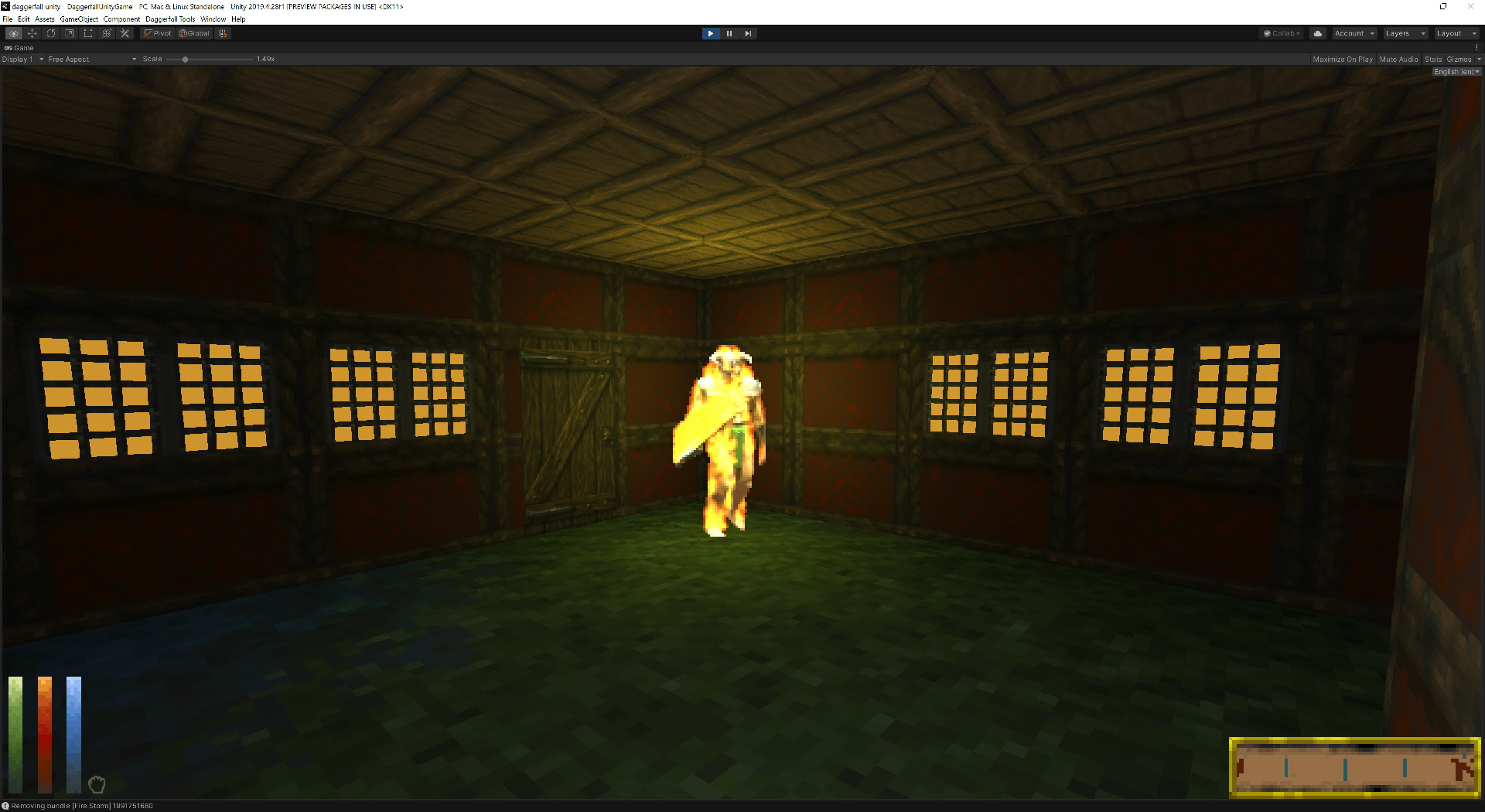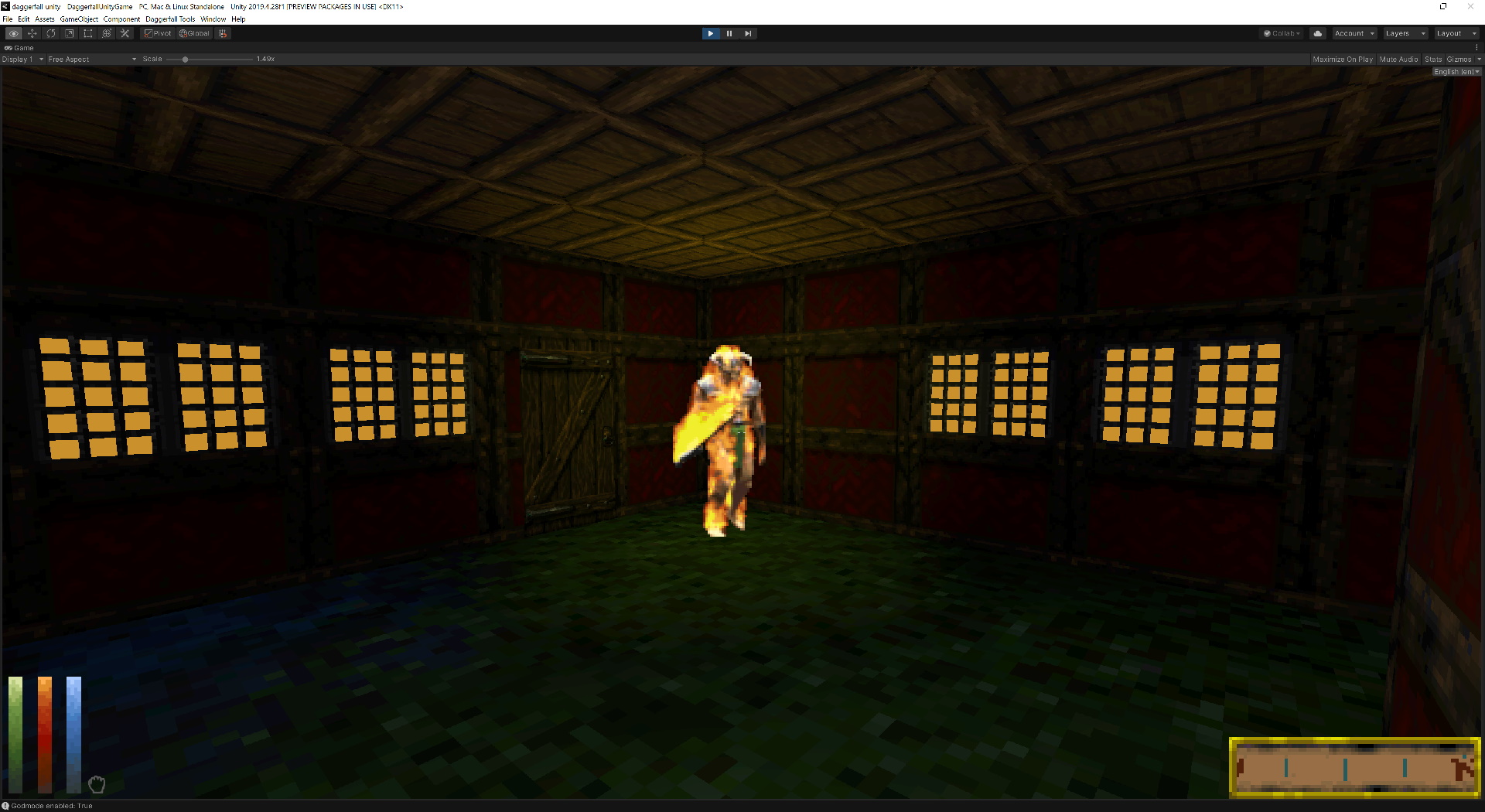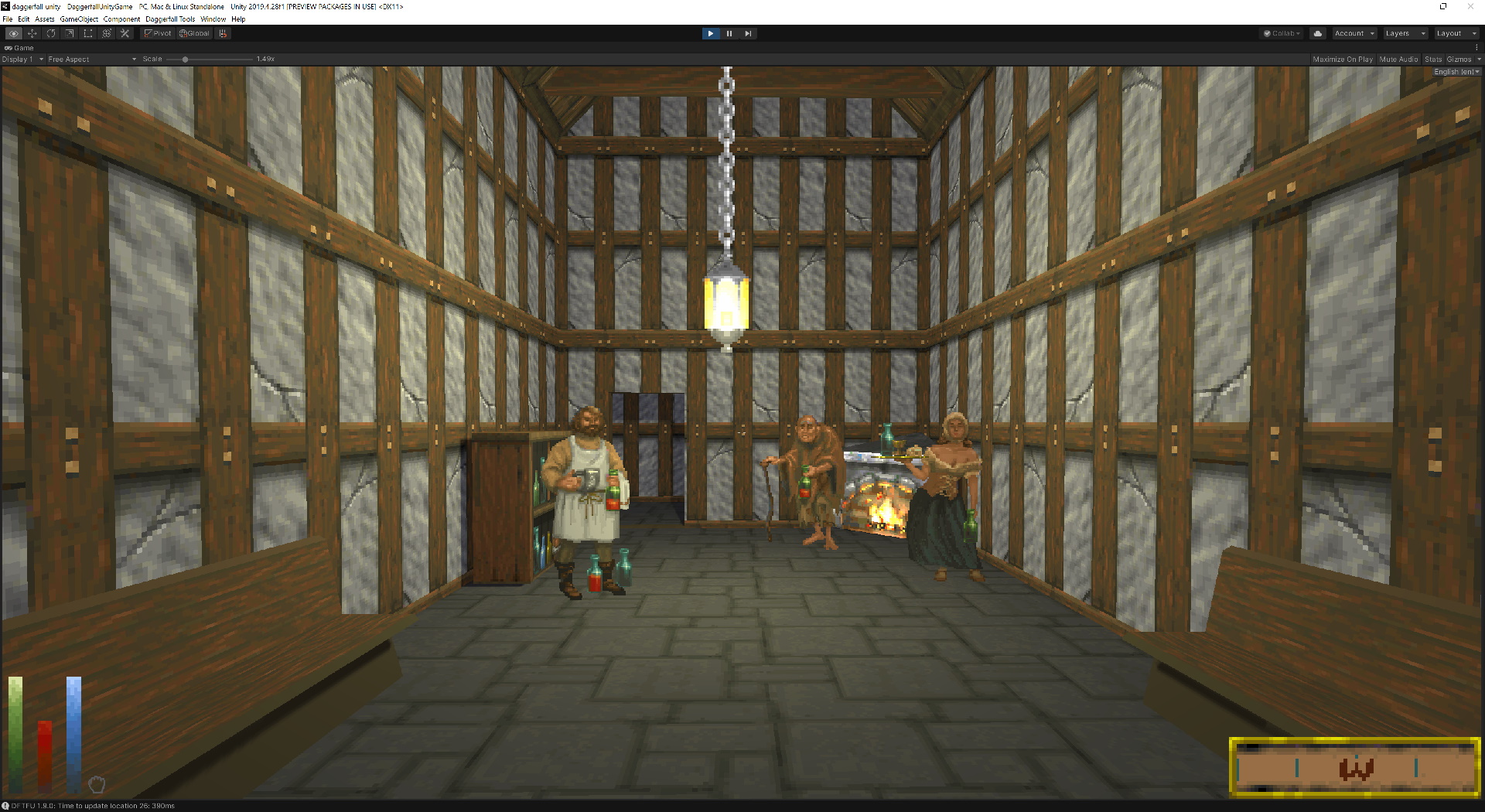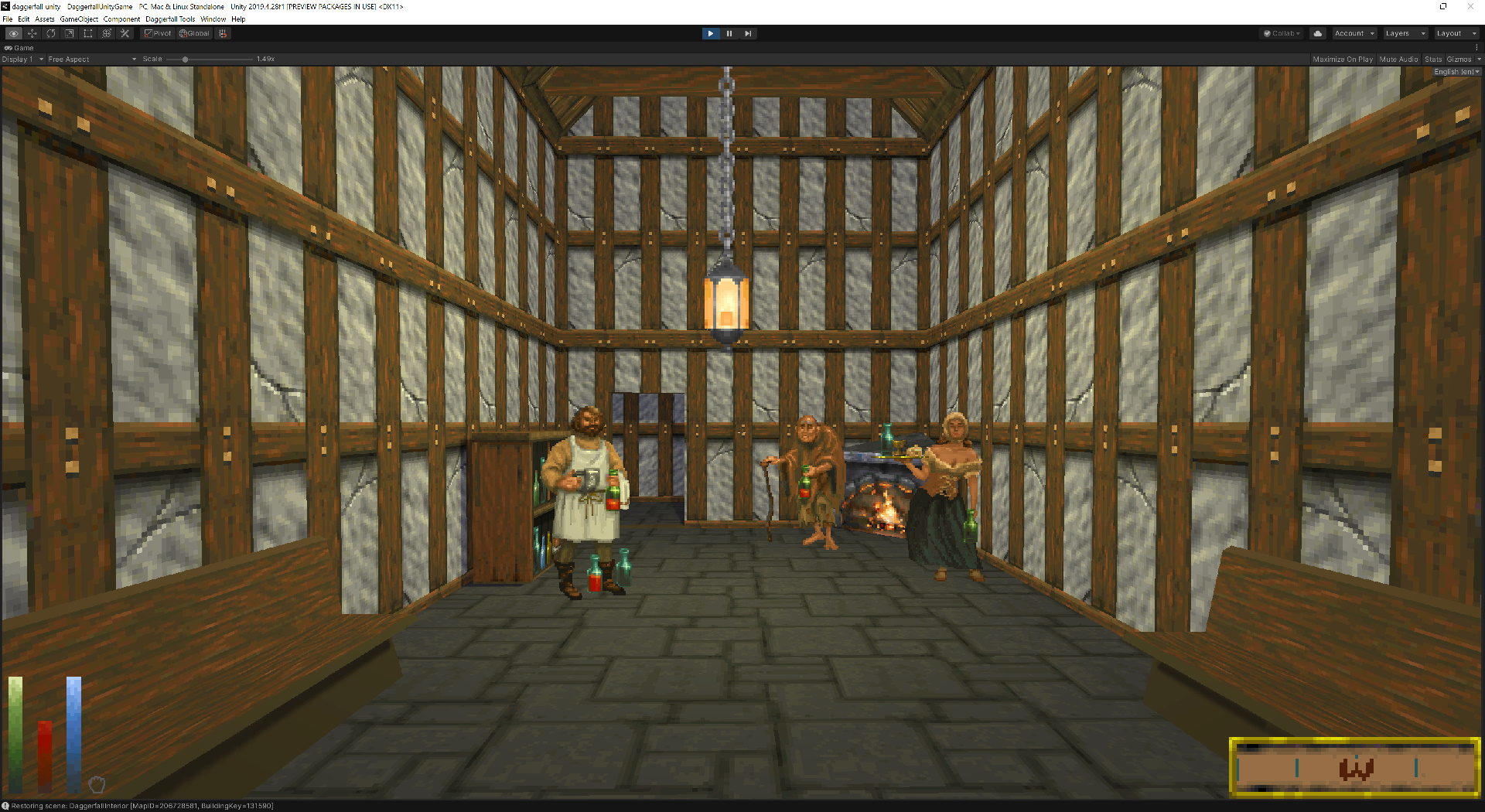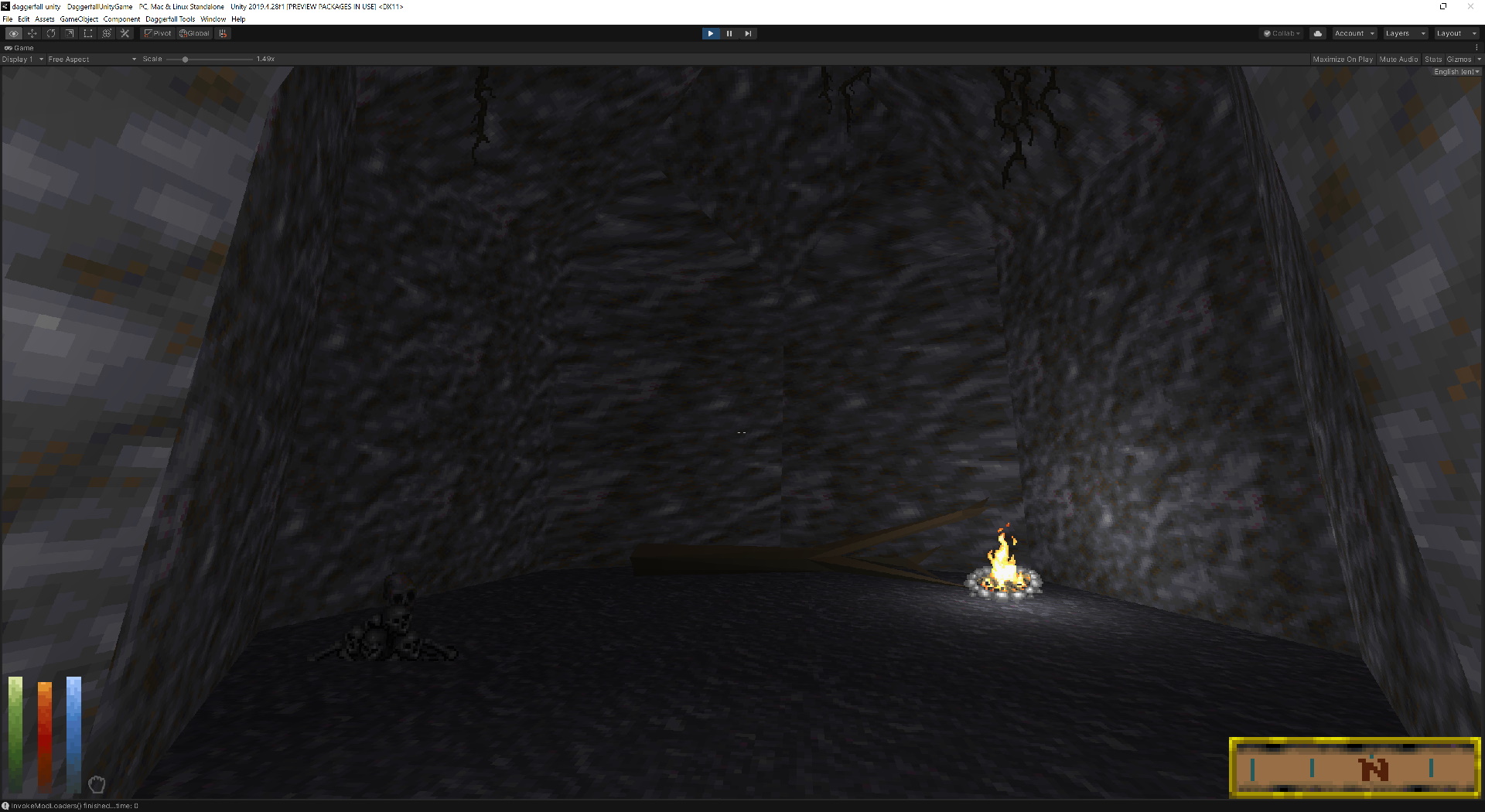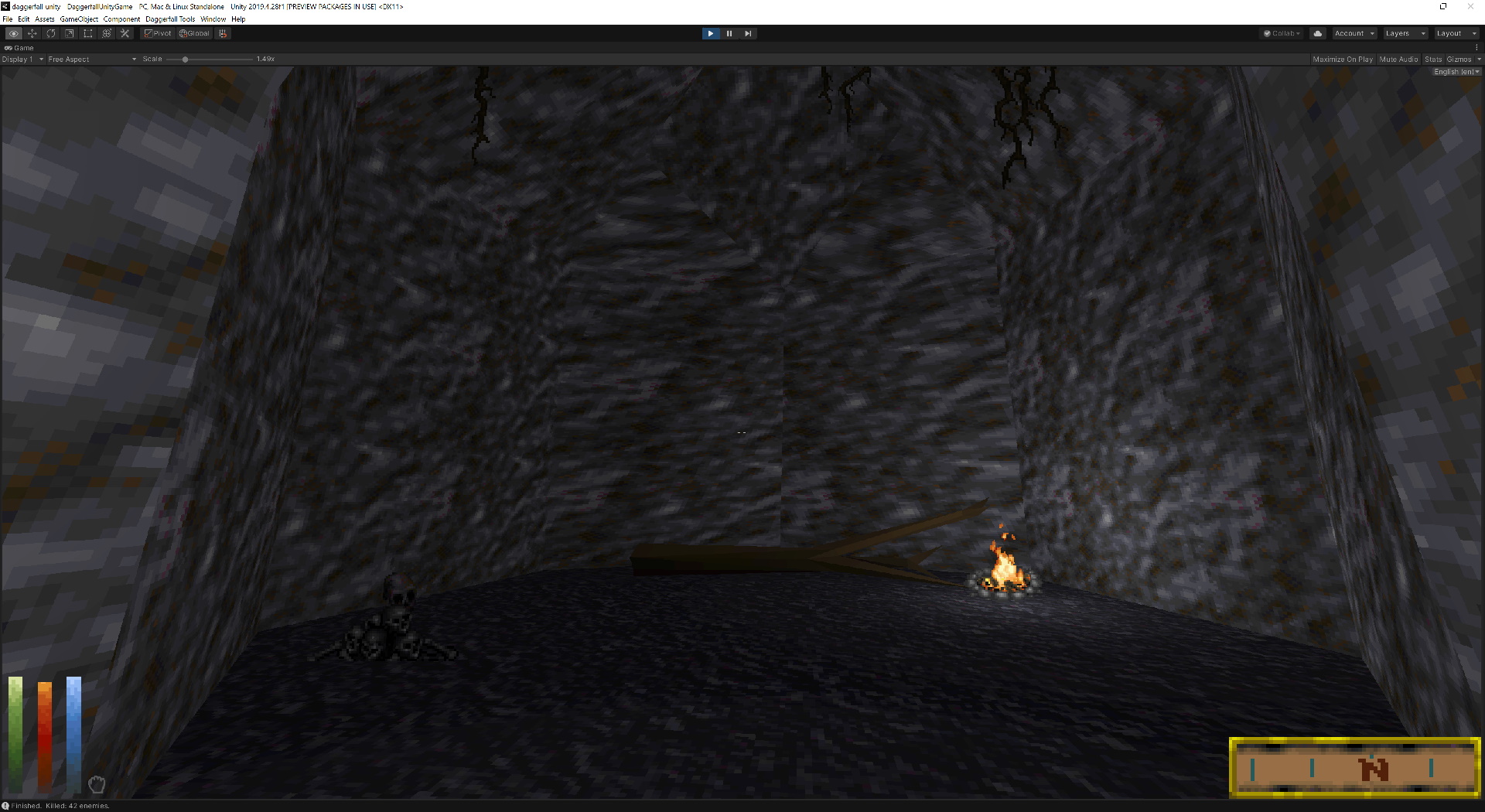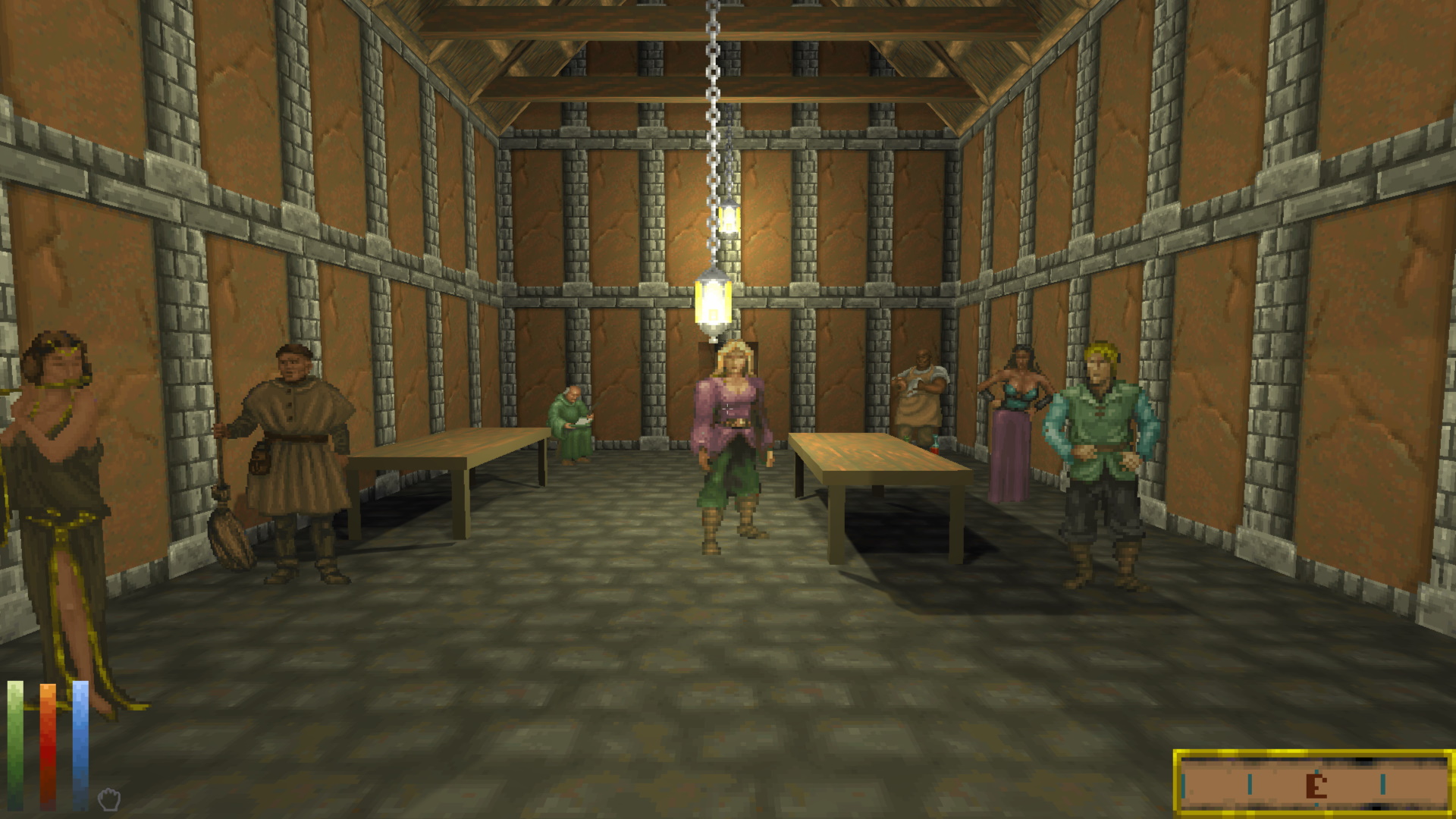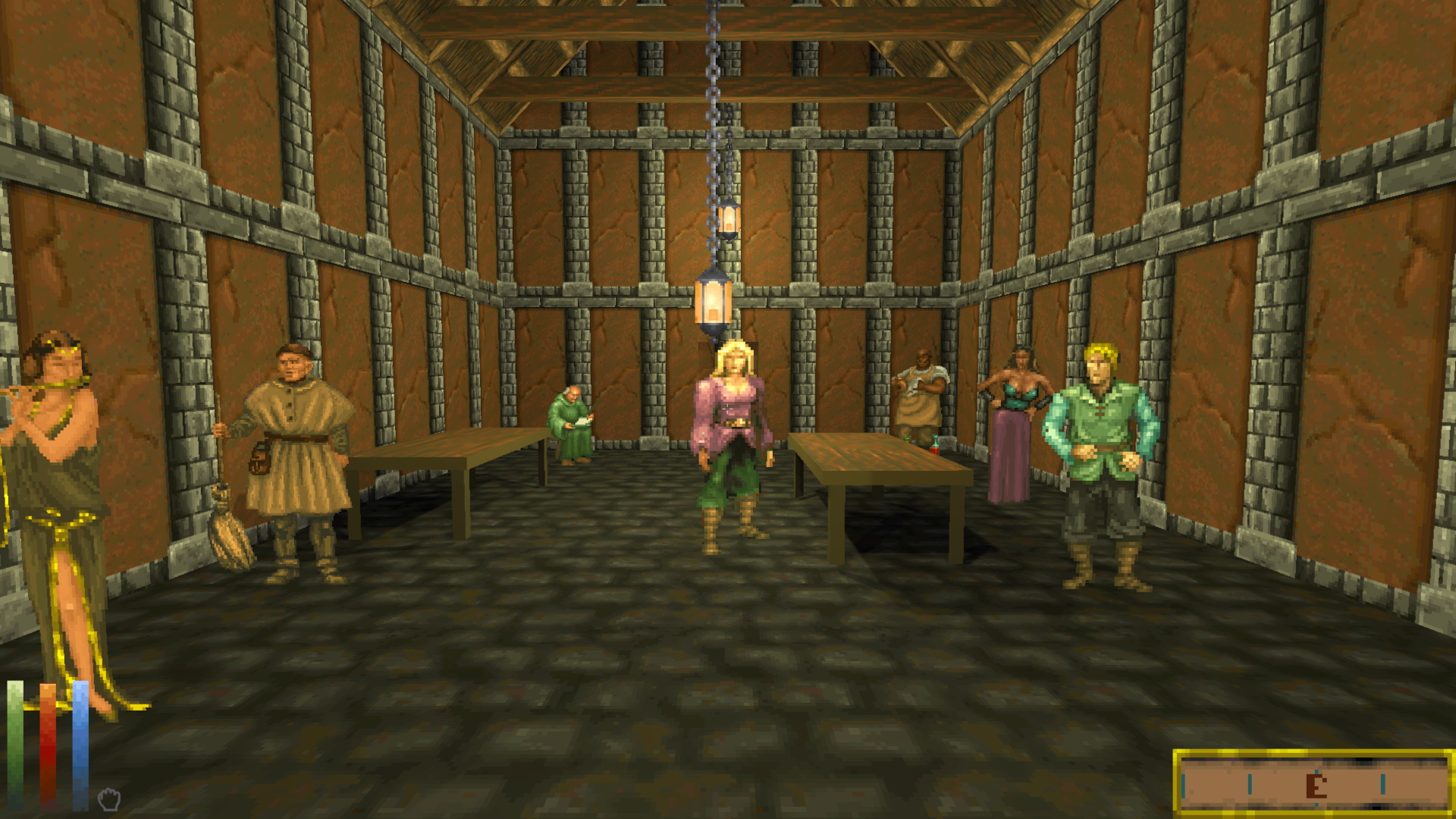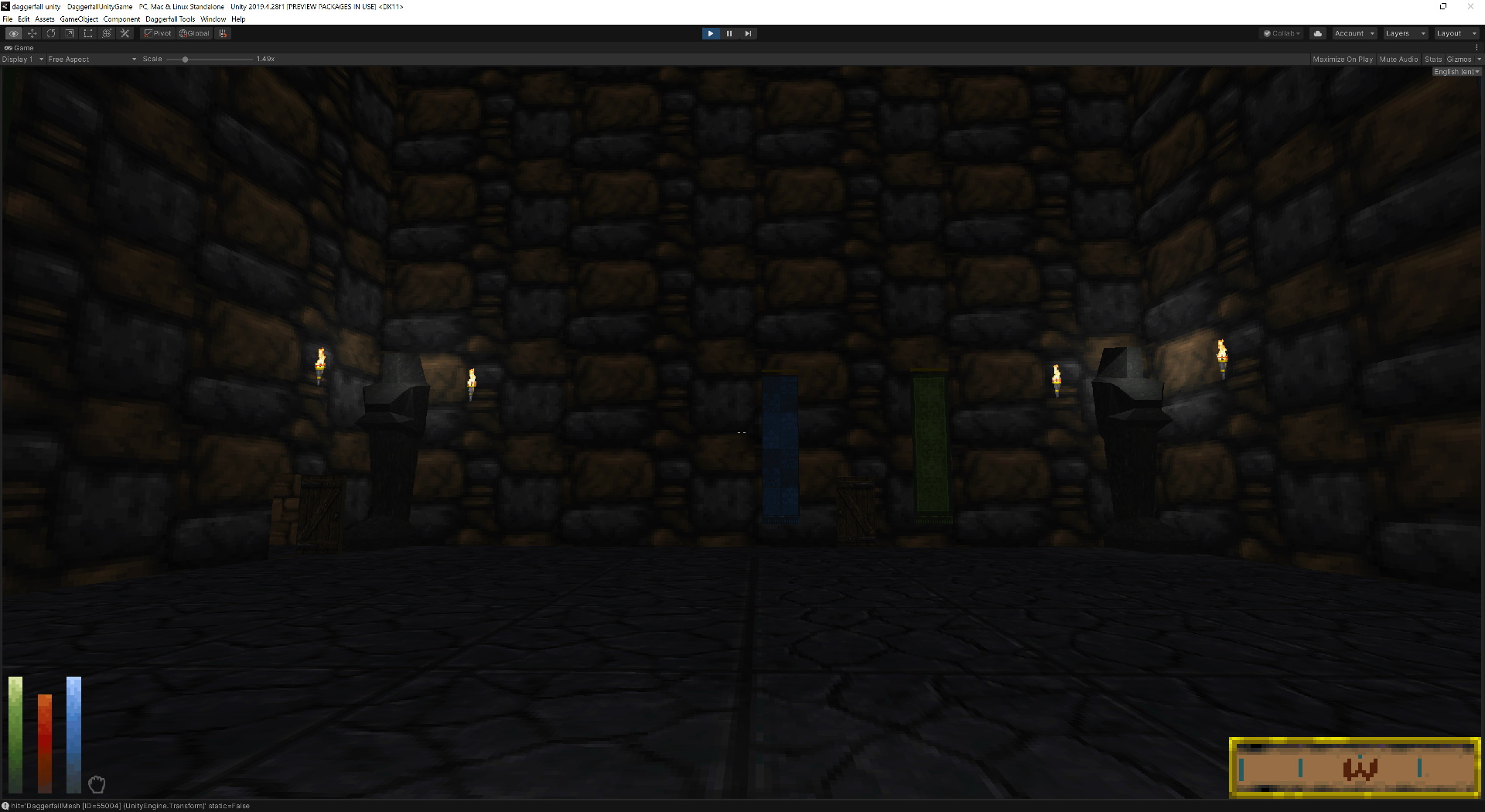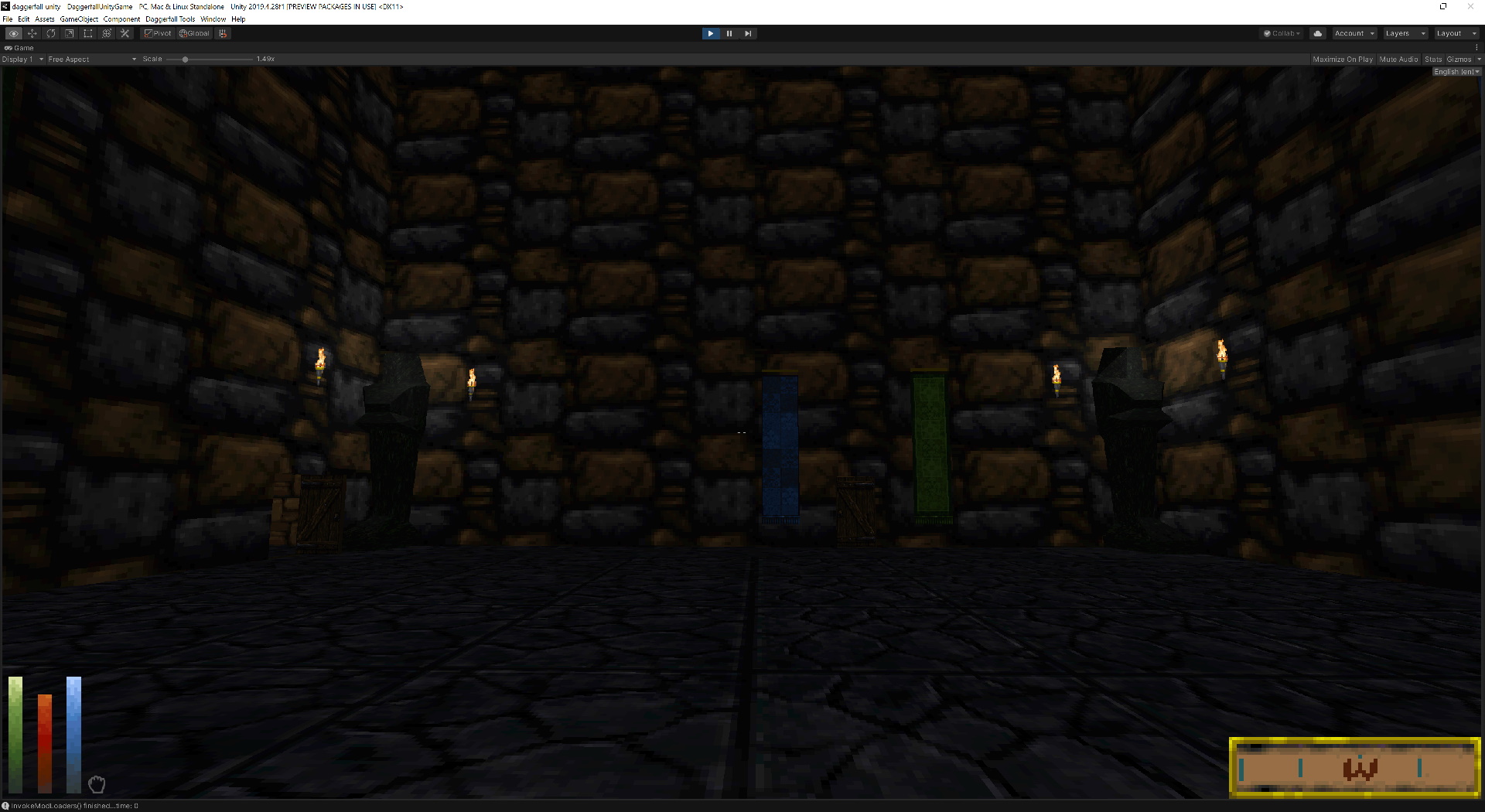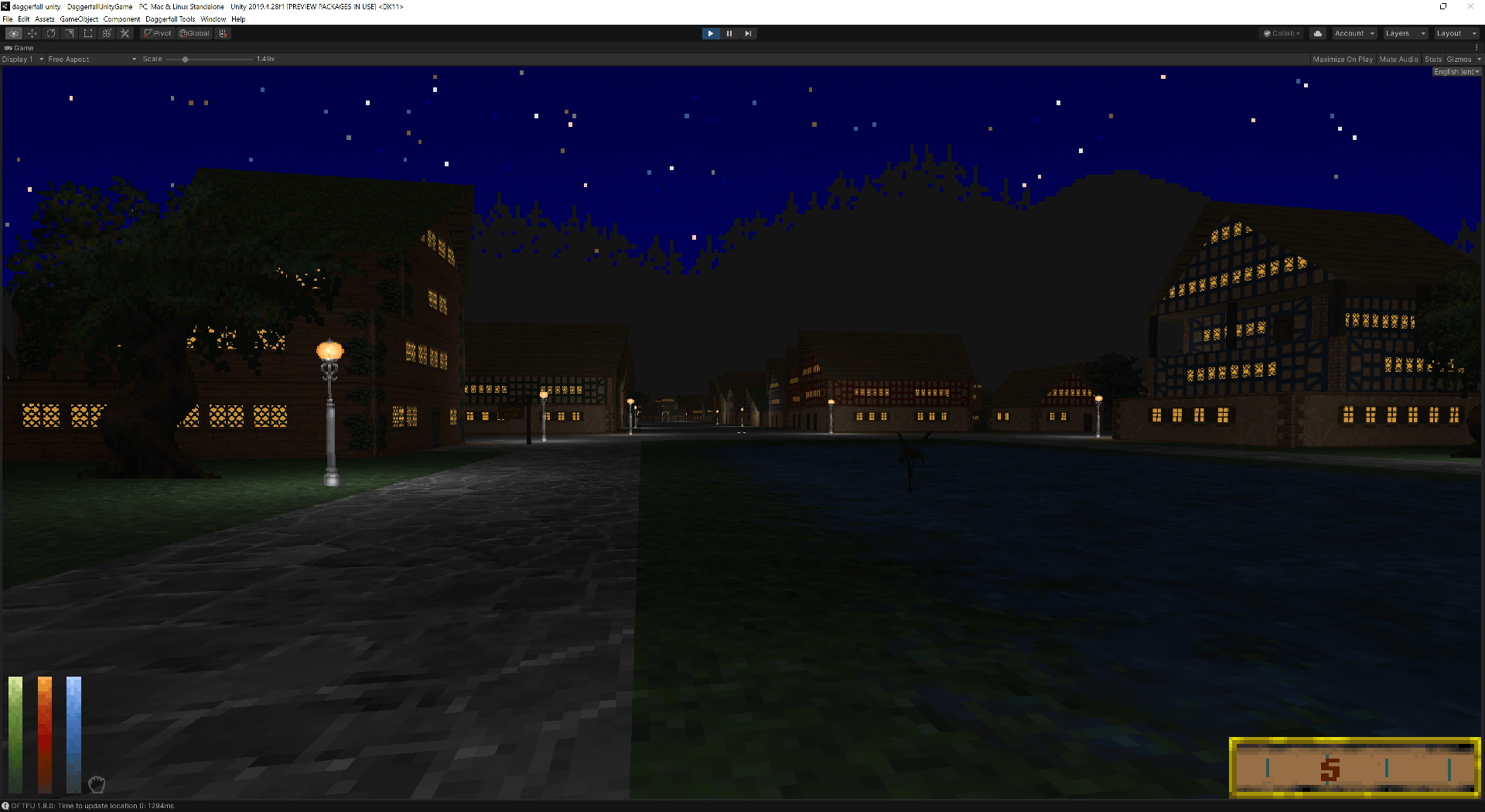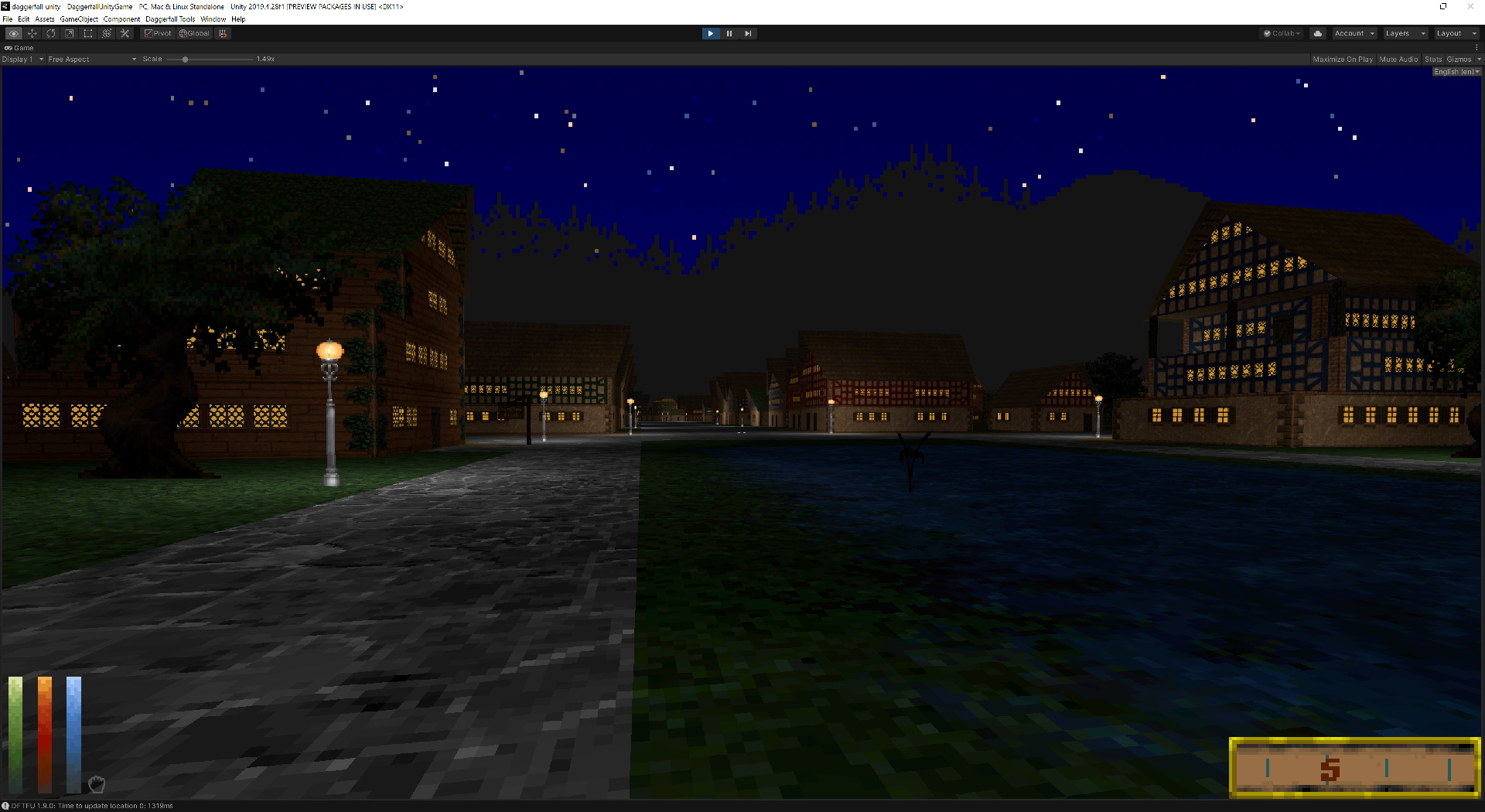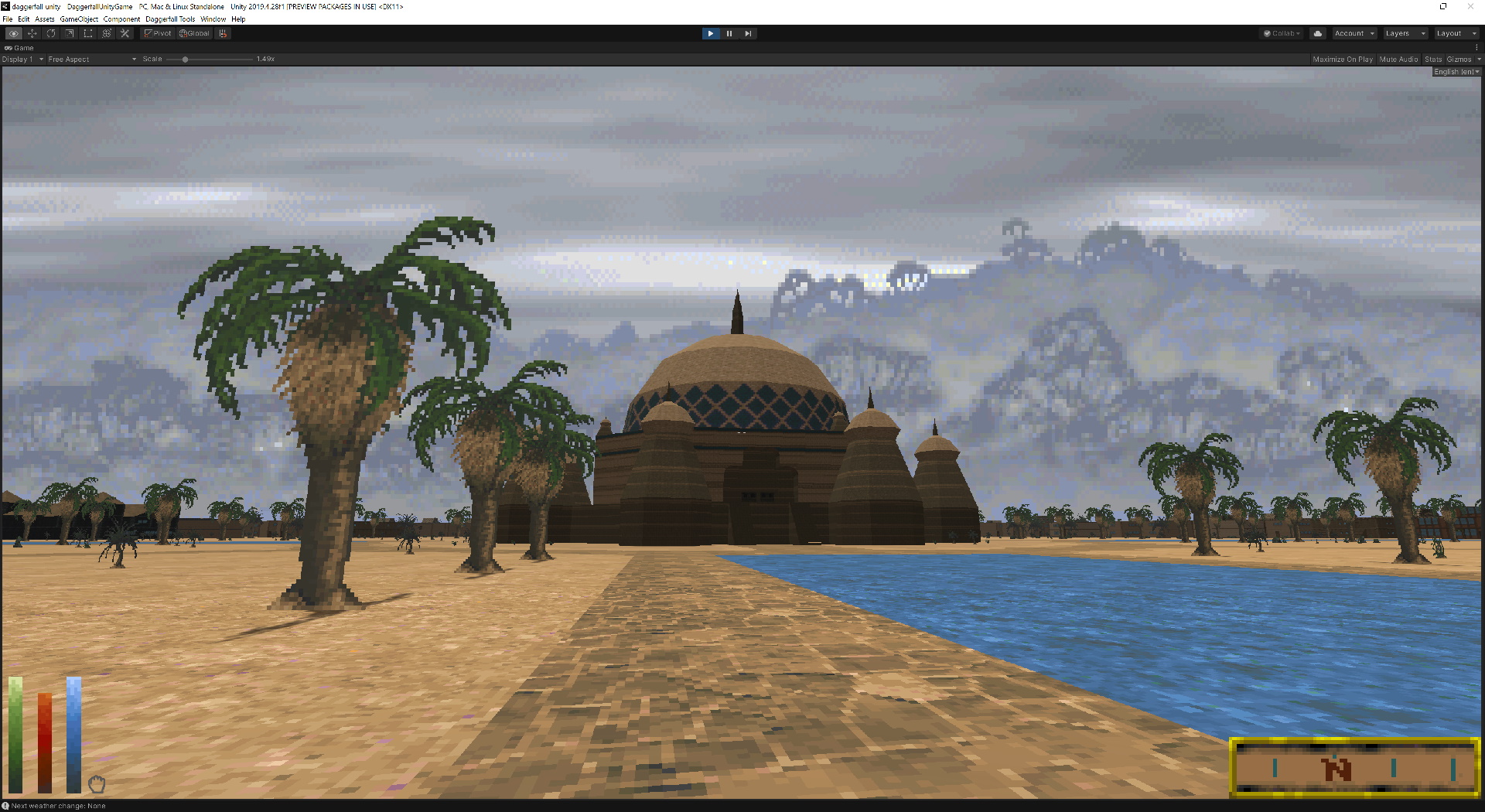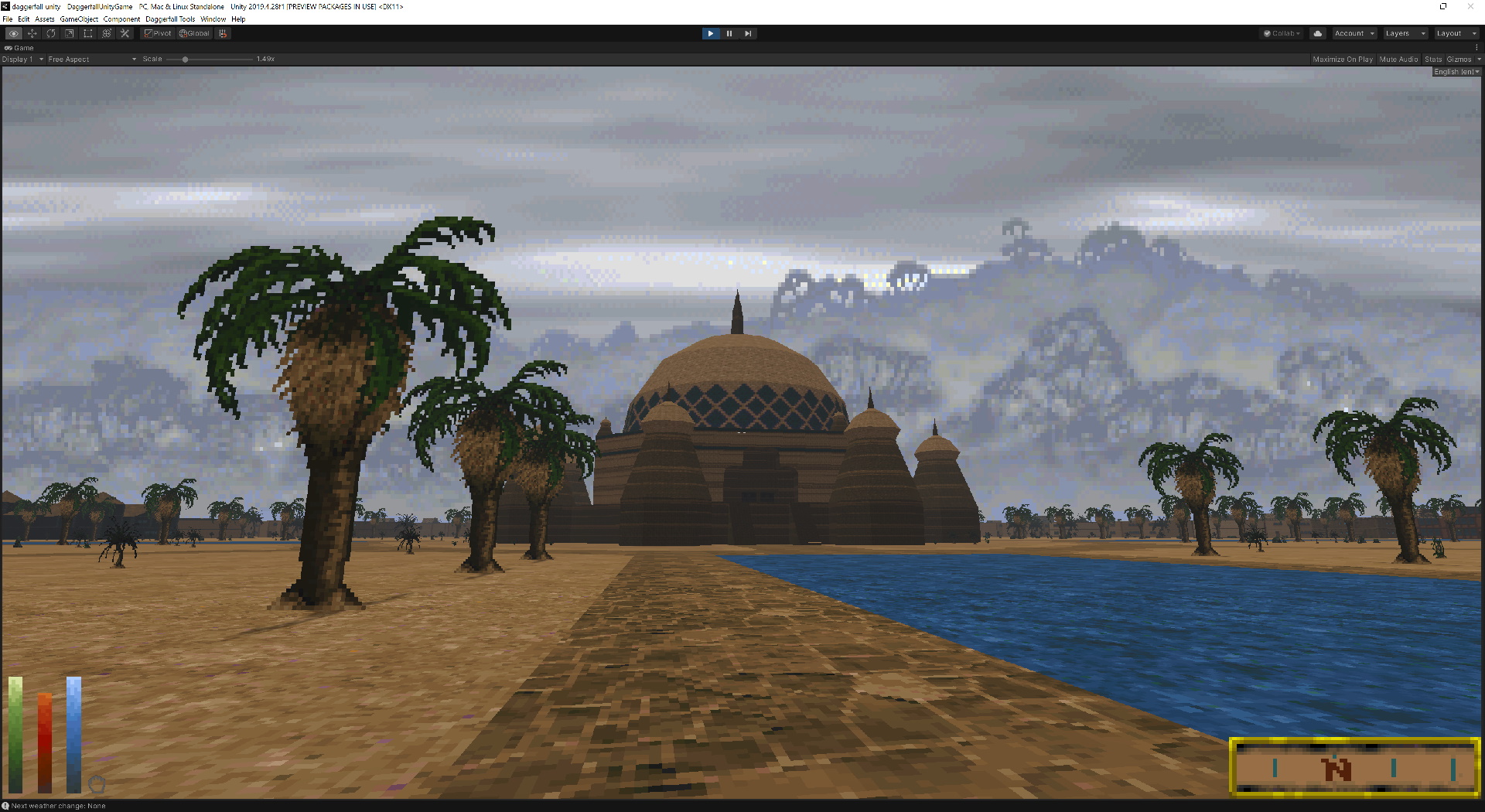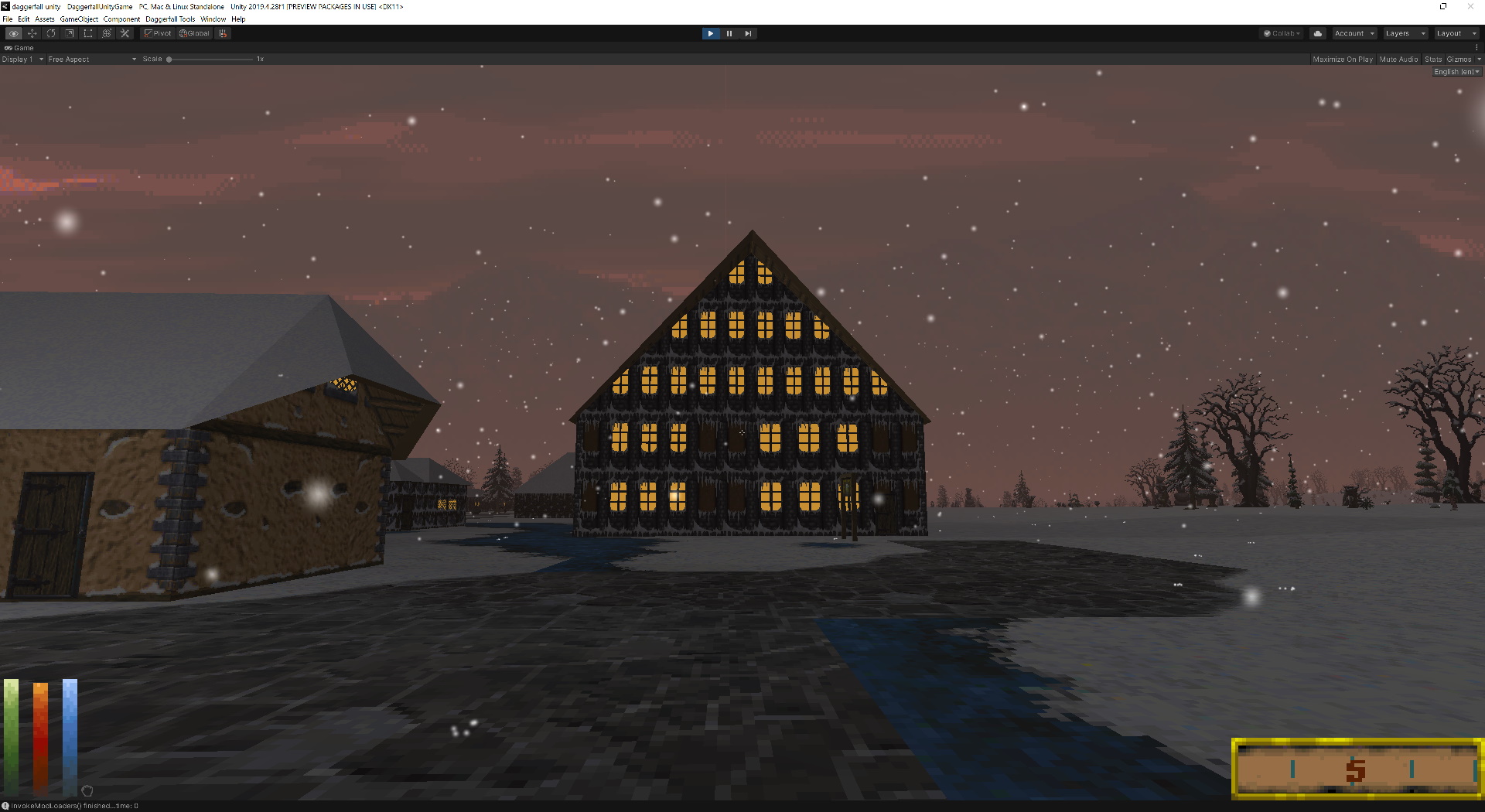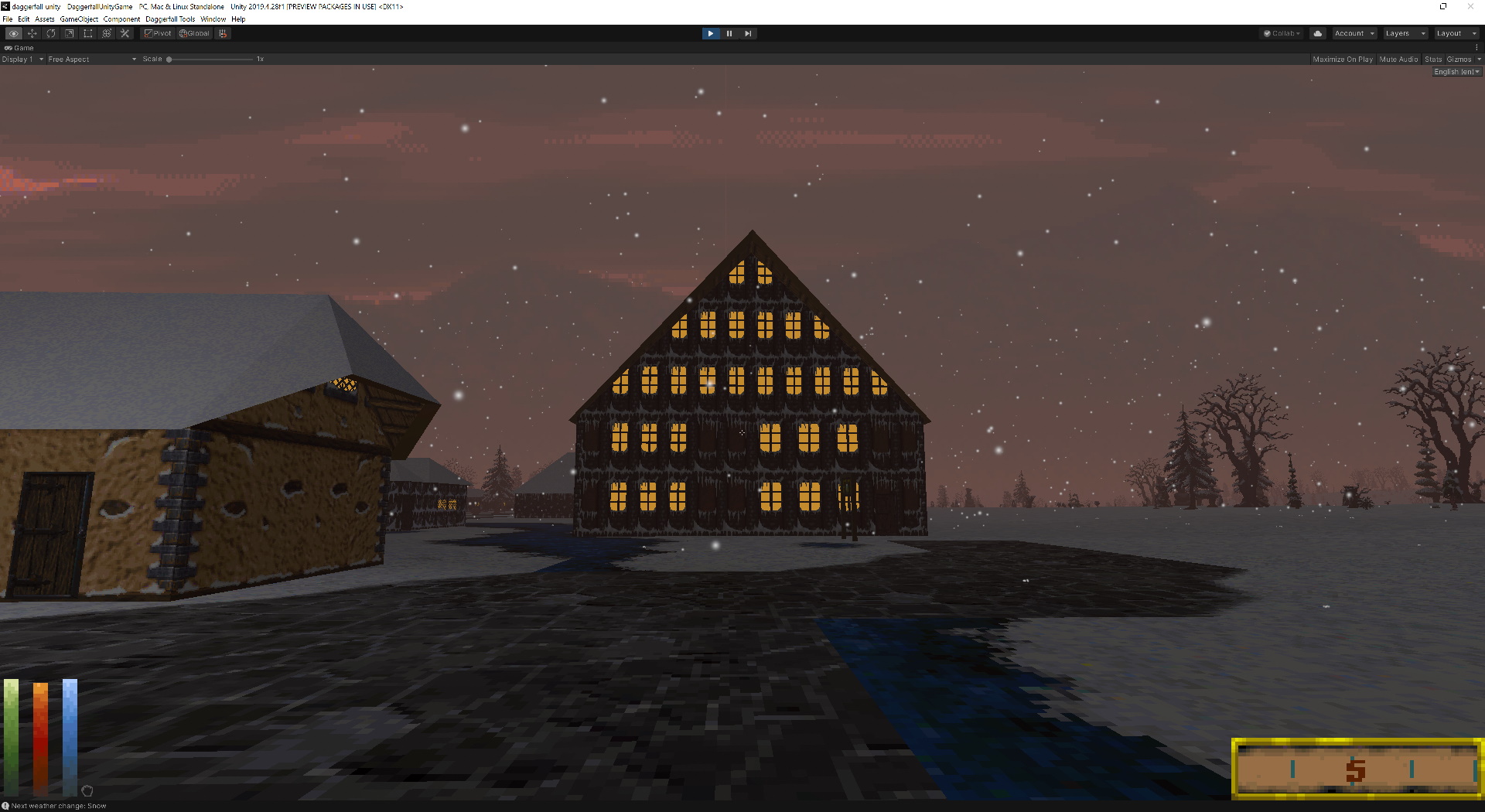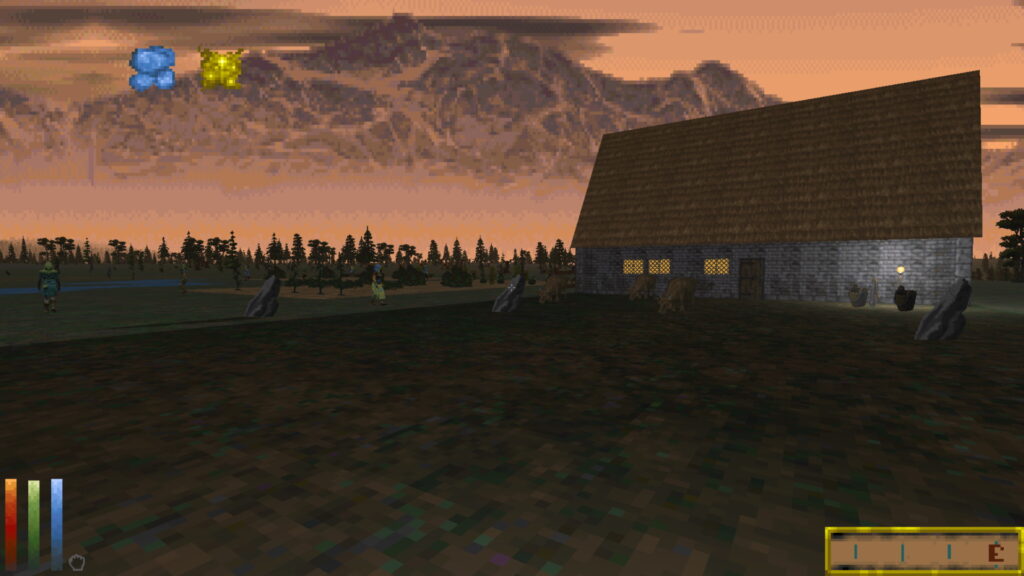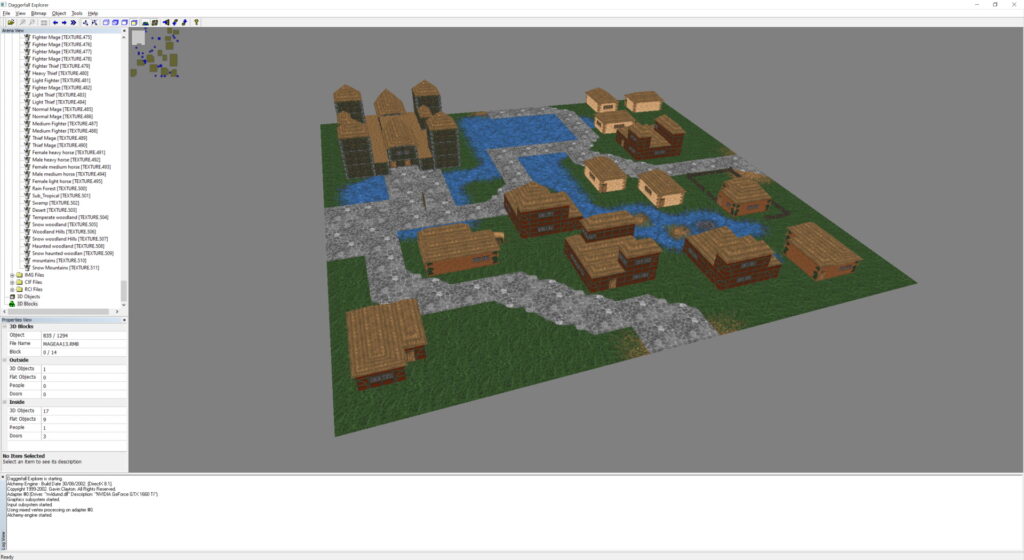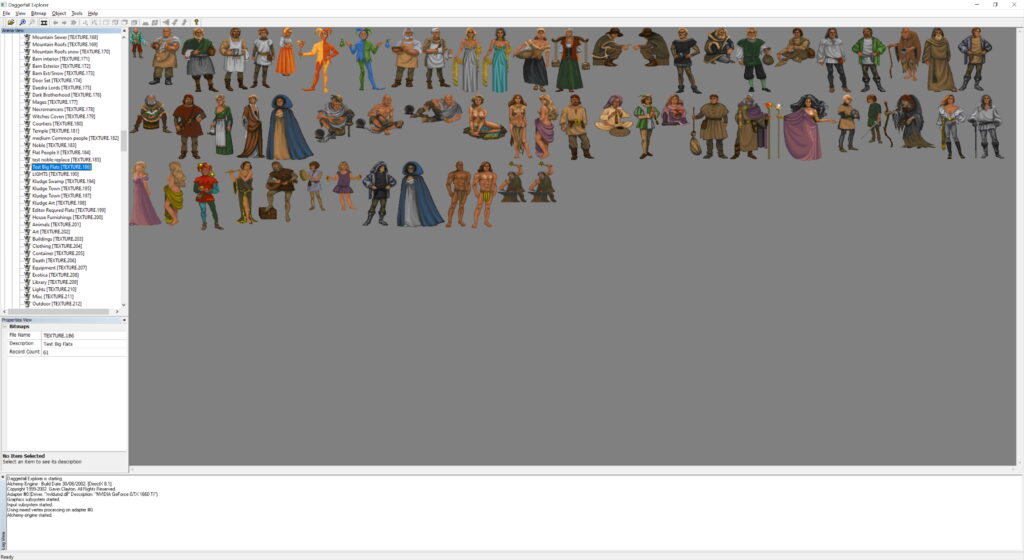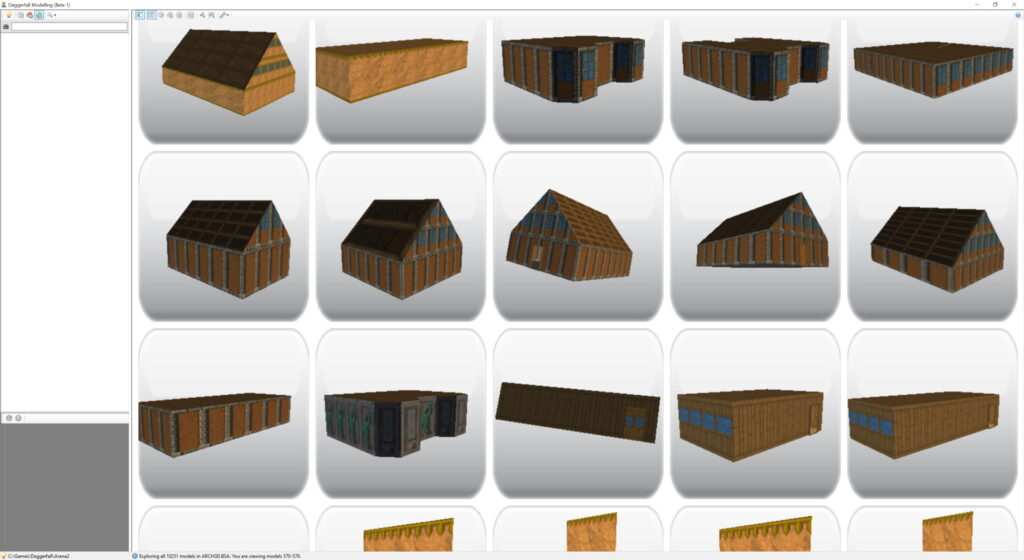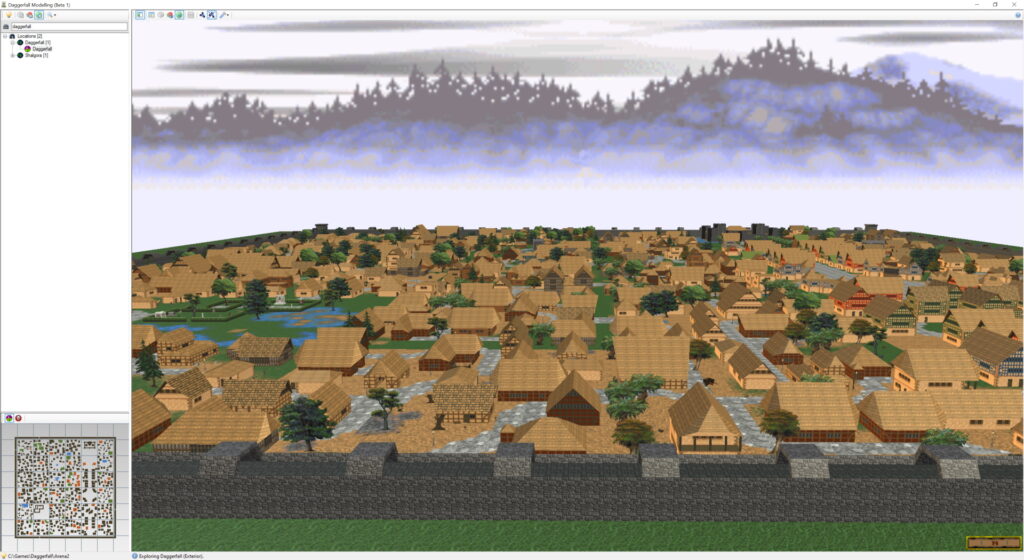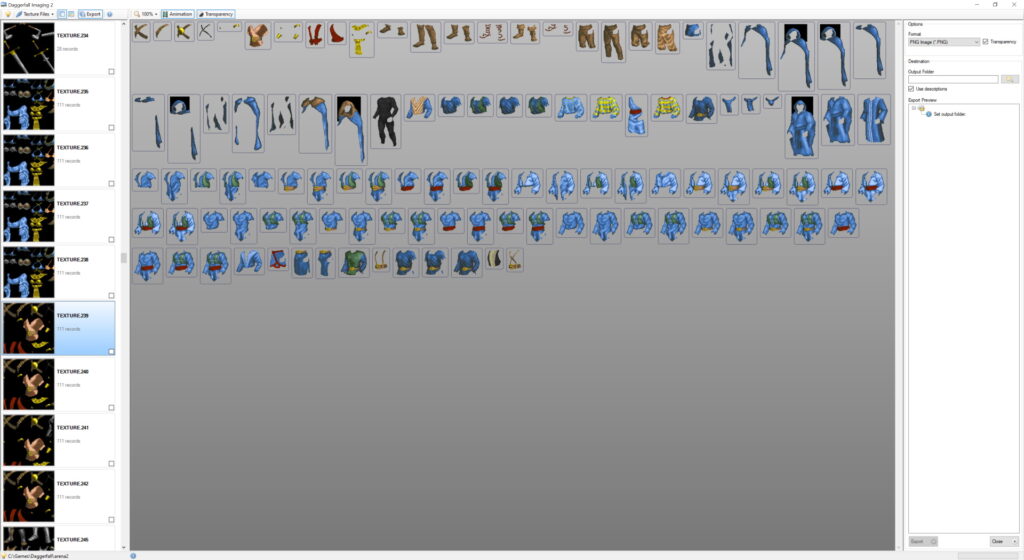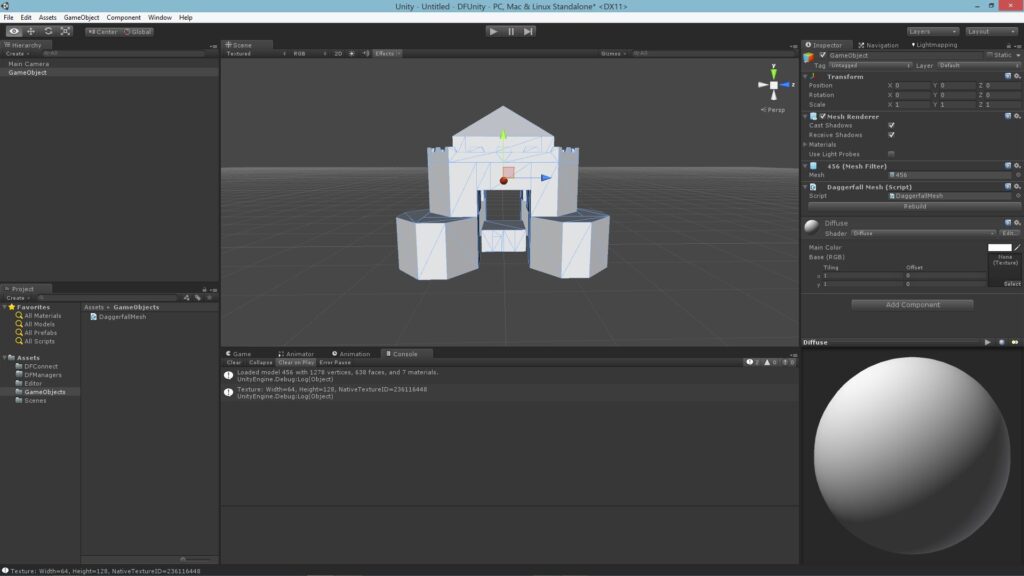This article has been moved to the following Wiki page on Daggerfall Unity GitHub.
Category Archives: Featured
Using Steam Release of Daggerfall with Daggerfall Unity
This article has been updated and moved to the following Wiki page on Daggerfall Unity GitHub.
Daggerfall Unity 0.13 Rendering Update – Part 3
In this third and final instalment, Daggerfall Unity’s rendering review wraps up by fixing more bugs and giving Retro Mode some overdue love. Preview release 0.13.3 is now available on Releases page.
To quickly recap, this review set out to resolve problem of specular “shine” from Unity’s default Standard shader, switch to more accurate and flexible linear lighting space, and upgrade postprocessing stack to PPv2. Along the way, we fixed many small problems with loose texture mods and reviewed lighting. Almost every part of the game involved with drawing something to screen was inspected and tuned up if tuning was needed.
Thanks to community feedback, we were able to address several issues created by initial 0.13 preview release. Our new shaders were extended to support more PBR capabilities. The game received an extensible “Effect Settings” UI to configure postprocessing and other effects at runtime. We helped several mod authors overcome compatibility issues so their mod works with 0.13 and beyond.
With all the large changes now settling down, we could start refining a few things. Here’s what’s new in 0.13.3.
Remove Nature Shadows
Projecting shadows from 2D billboards comes with downsides. These are just 2D cutouts rotating to face camera, so their shadow either twists and turns with billboard or stays fixed in place. Fixed shadows look better overall, but results in any asymmetry becoming disconnected from cutout when seen from the wrong angle.

Nature shadows had other tradeoffs too. In deferred rendering, screen objects always receive shadows, which means trees received self-shadow artifacts while rotating. To workaround this problem, it was necessary to render nature objects in transparent queue which doesn’t write to depth buffer. This in turn created other problems with rendering elements relying on depth information.
After trialling more solutions and workarounds, it became obvious these shadows were causing too many issues for a minor aesthetic hack that only looked good some of the time. Considering classic didn’t have tree shadows either, the best solution was to simply remove them.
If you prefer these nature shadows despite their limitations, you can switch them back on by opening settings.ini and changing “NatureBillboardShadows=False” into True.
Please keep in mind that enabling nature shadows will revert them to transparent rendering queue, so trees and other nature billboards will not operate fully with effects requiring depth information – Ambient Occlusion, Retro Mode Postprocess, ColorBoost, to name a few.
Retro Mode Enhancements
Retro Mode is a feature in Daggerfall Unity where camera renders to a 320×200 or 640×400 resolution target before scaling output into your display area. The feature also comes with postprocess settings for palettization or posterization to crush palette down to fewer colours with neat side-effects like colour banding from nearby light sources.
From 0.13.3, Retro Mode is now in the Game Effects UI. You can access these settings from drop-down arrow at top-left of screen when game is on pause menu.
In addition to previous settings for retro mode and postprocess, you now have the option to adjust render scale into 4:3 or 16:10. Enabling either of these settings will scale output to selected aspect ratio inside your actual screen area. If you have a wider screen, e.g. 16:9, then vertical pillarbox bars are added.


Previously this aspect correction was only available as a hacky workaround by fiddling with resolution and UI scaling settings, which was error prone and didn’t work under all platforms. Now with this in Game Effects UI, you can switch around these settings at runtime without restarting game.
If you’re coming from an older version of Daggerfall Unity and have already setup Retro Mode based on the old hacky method, please reset your game resolution back to something with correct aspect ratio for your monitor. For example, if you have a 1920×1080 monitor and set your game resolution to 1280×960 to force the aspect change, please set your game resolution back to 1920×1080 or some other 16:9 resolution. You also no longer need to enable “FreeScaling” option, which has been removed from 0.13.3. This is now all handled automatically in-game from checkboxes shown above, along with fixes for problems created by the old FreeScaling option.
One final note about Retro Mode – now that you can switch settings at runtime and change aspect ratio, not all mods will support runtime switching of resolution or aspect. Any mods rendering to a stacked camera (e.g. Enhanced Sky, Distant Terrain) will need added support for runtime resolution switching (update: Enhanced Sky has this support from v3.0.2). Also custom UI mods might need to add aspect handling based on how they calculate screen position. If you have problems with a mod in Retro Mode, try restarting game, switching off aspect correction, or switching off Retro Mode entirely.
ColorBoost Effect
The best way to introduce ColorBoost is by talking about darkness in dungeons. Daggerfall dungeons aren’t dark, exactly. They’re actually quite bright near player then ramp down sharply into darkness after 30 metres or so. This is technically a requirement of lower draw distance in classic, but it creates a uniquely claustrophobic feeling. In classic, even light sources fade into darkness at range. To put it another way, there’s a high contrast between brightness levels depending on distance from player.
See below classic screenshots for example. Here our player is standing near throne lift in Privateer’s Hold. Note how environment around player is rather bright then ramps down into blackness at farthest point.
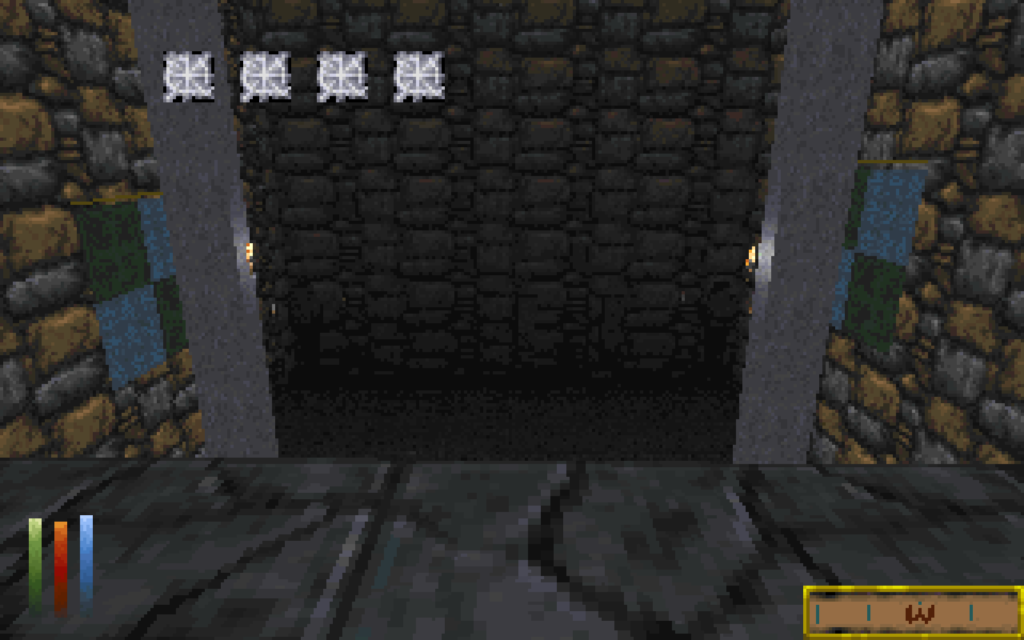
If you walk down toward that farthest point and turn around, now the brightly lit area near throne is plunged into darkness and world near player is bright instead. Step back a few more metres and area above stairs becomes totally black. Even those bright torches will fade away.
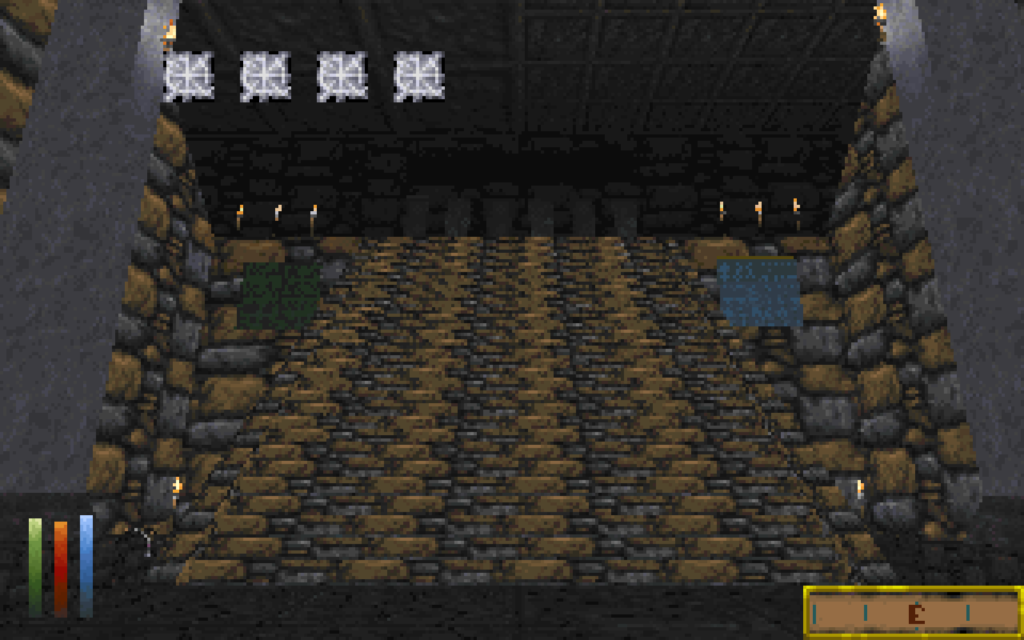
Daggerfall Unity uses a modern naturalistic lighting system where this kind of thing doesn’t happen. Lights have radius and intensity, and geometry is either touched by some amount light or not. In a naturalistic environment, torches don’t stop casting light behind themselves just because player walked a few dozen metres away.
It’s not quite feasible to capture classic’s rendering and lighting perfectly here (totally different engines and lighting systems after all) but it is possible to create more contrast between near and far brightness to capture this same atmosphere.
Let’s start with a screenshot of Daggerfall Unity, once again at top of stairs in Privateer’s Hold looking down. Note how distant torches still affect the wall behind them, and scene overall is rather uniform in brightness. A ramp down into darkness isn’t present at all.

Now ColorBoost comes into play. This postprocessing effect can both increase brightness near player and produce ramp down into darkness inside dungeons. Compare above screen with one below, and note difference in contrast between near and far points. Even the torches start to fade into darkness at range.

In addition to atmosphere, this gives you another way to tune brightness to your preference. Some ColorBoost will brighten things up without completely flattening or over-brightening whole scene. The dungeon falloff effect has adjustable strength down to 0 (disabled).
Here’s a another shot of stairs in Daggerfall Unity at 320×200 16:10 Retro Mode with adjusted ColorBoost settings. This is finally approaching reasonable parity with classic Daggerfall’s dungeon atmosphere despite underlying engine differences.

ColorBoost was originally intended to help in Retro Mode with posterization / palettization enabled, and it’s recommend to use a good amount of ColorBoost in combination with those effects. But you can enable ColorBoost at any time, with or without Retro Mode, and it will work alongside your mods, lighting setup, and other settings.
Speaking of mods and settings, you’ll likely need to dial-in ColorBoost to suit your environment and preferences. Everyone can have a unique setup and world can light very differently as a result. For this reason, ColorBoost config page has several sliders to help dial-in Radius of effect, global Intensity, strength of effect in Dungeons, Exteriors, Interiors, and control Dungeon Falloff. Like all effects, ColorBoost is disabled by default.

General Improvements & Fixes
This release also brings several minor fixes and refinements:
- Don’t use transparent queue for standalone cutout billboards so they operate with AO and other depth effects
- Fix volume collider blocking spells and other missiles (fixed in 0.13.2b)
- Flag window textures in archives 171-173 to support emissive from replacements
- Allow changing retro mode settings at runtime
- Remove global UI FreeScaling method, this is now part of retro mode aspect correction
- Fix overlapping text in popup message boxes with FreeScaling enabled
- Change protections on MaterialReader Uniforms to public
- Fix StreamingWorld.TrackLooseObject “mapPixelX” and “mapPixelY” (KABoissonneault)
- Fix retro mode colour accuracy with higher precision render textures
- Hide spell icons when pause options dropdown is open
- Refine automap panel sizing with custom screen rect
Conclusion
We have now reached the end of rendering review in 0.13. Unless a blocking issue is found, the “preview” tag will be dropped from next release. Moving forward, there are no more large changes scheduled to engine or rendering, only bug fixes and minor refinements. This is to ensure best possible stability and mod compatibility moving towards 1.0.
If you are a mod author, please ensure your mod is rebuilt and tested compatible for 0.13.3. This release is very close to next full Beta release without “preview” tag.
Thank you for reading, and for playing Daggerfall Unity!
Daggerfall Unity 0.13 Rendering Update
There are some long-standing items on Daggerfall Unity’s Roadmap that have at last found their way into the game. These changes relate to visual rendering of classic textures in Unity engine and how they interact with lighting. There’s also a long-overdue update to the postprocessing stack. To summarise everything before getting into details, these changes are:
- New default shaders for classic textures
- Switch rendering from Gamma to Linear colour space
- Lighting review
- Update postprocessing stack
New Default Shaders
You might have noticed the visuals in DFU have a kind of silvery “shine” on top, and some textures tend to wash out easily under certain lighting conditions. Examples are objects that emit light, such as lanterns, and naturally bright textures like snowy terrain at midday. Even when using retro rendering with palletization, deep blacks will tend to shift value towards lighter greys.
The reason for this is somewhat technical. A concise version is that modern engines like Unity use something called Physically Based Rendering (PBR) which attempts to simulate the physical properties of a material and how it interacts with light. However, old games like Daggerfall predate physical material properties such as normal maps, smoothness maps, etc. and instead have only basic colour information in a single texture. When attempting to render these simple textures in a PBR engine without any other material properties, they are perfectly smooth and will reflect light in unsatisfying ways. This can give objects a shiny kind of look, as if made from plastic or dull metal.
In fixing this, the goal was to correct lighting incongruity while using classic textures and still allow mods like DREAM to use PBR materials. It was also necessary for these different materials to work together in the same scene with any combination of classic and modded materials. This presented some challenges that were eventually overcome with the help of new shaders and several updates to material pipeline.
The best way to see the difference is to compare a scene in 0.12 and 0.13. Pay close attention to the dark areas of the rat while adjusting slider. You’ll notice in 0.12 screenshot the rat has a uniform specular shine that is removed in 0.13. You’ll see the same across the entire scene, although most obvious in darker textures.
To fix this specular shine required new shaders better suited to Daggerfall’s classic textures. These new shaders lean fully into the retro textures and use simple Lambertian reflectance like older games of the time. This leads to better colour sampling under most lighting conditions and fixes brighter areas from becoming overbright. For example, the lantern and Fire Daedra wash out to bright yellows in 0.12 using PBR shaders but show their true colours in 0.13.
While relatively basic, the new shaders still support Normal maps and Emission maps, and conditional compilation. They are more lightweight than Unity’s Standard shader and will perform slightly better on lower-end computers running without mods.
Gamma to Linear Colour Space
The next change was switching from Gamma to Linear colour space. This is another technical subject, but in short it relates to how colours are added and multiplied. Linear colour space leads to more accurate results with improved lighting falloff and softer shadows. The results can be subtle in unmodded DFU, but the combination of new materials and linear lighting uplifts every scene with deeper colours and improved contrast while eliminating bloom and flat specular shine.
With the change to Linear colour space, modded materials now have a chance to look their best at all times with more accurate colours and no unwanted bright spots near lights. Of course, all these changes also require lighting to be reviewed and materials tweaked so they still look good. This leads into the next item on the list.
Lighting Review
Linear colour space blends and lights differently than Gamma. Lights appear to have a larger radius and is more defined on edges. This is more accurate overall, but also different if you’ve become accustomed to Gamma lighting. As a result, all the light sources in the game need to be tuned so they aren’t too bright and still resemble the game as it was.
In general, dungeons will appear a bit darker from 0.13. The combination of new shaders, Linear colour space, and lighting review result in darker colours becoming more prominent. You can really see the flat silvery shine over everything in below screenshot when comparing 0.12 to 0.13. The dark parts of brick textures stay dark rather than shifting value towards lighter greys.
Towns are still nicely lit oases, with Linear’s different light falloff visible against sides of buildings in below screenshot. But the removal of flat specular shine means night-time scenes have better overall contrast between light and dark areas.
Daytime scenes will light much the same as there’s only a single directional light source (the sun). The change to Linear with new shaders also resolves the problem of terrain textures looking over-bright under a midday sun. Finally, the daytime light curve was adjusted to provide a longer plateau of sunlight around 10am-3pm.
Update Postprocessing Stack
For some years now, Daggerfall Unity has continued to use an older embedded postprocessing stack. This has now been removed and replaced with current Post Processing 3.1.1 via Unity’s package manager. This updates deferred fog and postprocess capabilities to be in line with current engine. It also required some minor code changes and retuning fog as some parts of the old Post Processing library have been deprecated.
Fog is roughly the same, other than being a bit thicker towards limits of view distance. Compare the distant trees and buildings in below winter scene.
Preview Release and Mods
Daggerfall Unity 0.13 will be available as a Preview release soon. Due to all the changes across asset pipeline, colour space, default materials, and postprocess stack, you should expect some mods that work under 0.12 not to work in 0.13. Mods that include new materials and shaders will be most affected. Any non-graphical mods, or those which only change game settings, should be unaffected or only need minor tuning.
It could take several weeks for mod authors to update their mods to be compatible. If you don’t want to help test 0.13 and provide feedback to developers and modders, you can happily stay on 0.12 until 0.13 release is out of preview. You can also run 0.12 and 0.13 side-by-side by unzipping releases to different folders and running different mod loadouts. Other than changes outlined above, the 0.13 release is identical in terms of gameplay and patch level to 0.12.
Looking to the future, this represents the last major change to Daggerfall Unity leading up to 1.0. Bug fix and general refinement will resume once 0.13 is considered stable.
Thank you for reading! I hope you decide to try out Daggerfall Unity 0.13 preview to help test mods and provide feedback.
Daggerfall Unity Beta 0.11.0 – Milestone Accomplished
The first official beta release for Daggerfall Unity is now ready to download from Live Builds page. This is only a small update over 0.10.28 release, which was a “pre-beta” test just to make sure there were no showstopping bugs before Beta proper. If you haven’t already, please read that article for more information about recent builds.
So yeah – beta. The game is feature complete and working well. If you’ve been waiting to play Daggerfall with smooth controls, quality of life improvements, and epic mod support, there has never been a better time than now. We still have some quirks and bugs that need to be fixed, but after 18 months of intensive fixes and improvements during alpha, this game is in pretty good shape. The feedback loop of near-monthly releases to community with rapid fixes over several years has proven to be a good formula for this kind of game. This will continue right through to 1.0 and beyond to make the best version of Daggerfall possible. Only the frequency and magnitude of updates will slow down as there’s not much left on the plate beyond fixing bugs and gradually expanding mod support.
If this is your first time here – welcome! You might also be wondering what Daggerfall Unity is, how it came to be, and who were the people involved? So rather than just info-dump the small number of changes in this release (scroll to the end for that), I thought it might be a good time to take a look back at the journey leading up to this point. We only get to reach beta once, so pull up a chair and settle in for the ultra-condensed version. I won’t bore you with the full history, you can check out the About page and this tweetstorm for more about me and this whole journey.
The Early Days 1996-2003
My name is Gavin “Interkarma” Clayton and Daggerfall Workshop is my site. After buying Daggerfall in 1996, I fell in love with the game. So much so that by 2000/2001, I began writing tools to view textures and 3D models from the game, including small chunks of locations called “blocks”. This culminated in a program called Daggerfall Explorer written for Windows 95, which incredibly still works today. Daggerfall Explorer was written in C++ and used a custom 3D engine on top of DirectX 8.1 which I called the Alchemy Engine. Sweet name, right?
Notable other people around this time were Dave Humphrey who founded the UESP, and Donald Tipton who made several excellent tools. There were many others hacking away at the game data formats back then, and my early efforts build directly on the knowledge they shared. Not everything was well understood, however. Some real basics like how UV coordinates were stored and several other file formats were still a complete mystery. These would continue to be understood as the years rolled by thanks to a sharing and wonderful community.
I continued to build more tools for Daggerfall such as Daggerfall Cartographer (view full cities), Daggerfall Imaging (view and export textures), and Daggerfall Jukebox (play and export music). Late in this tool-building stage, around 2003, I actually attempted a Daggerfall remake that didn’t get off the ground. I didn’t have the experience and the necessary social framework for this kind of project simply didn’t exist, so this attempt failed rather quickly. It was a good learning experience, but my interest faded for a while after that.
More Tools 2009-2012
In 2009, I got back to work building more Daggerfall tools. This time around, I constructed a C# library called Daggerfall Connect to read the game data formats and update with some of the new understanding of file formats that had emerged through the intervening years. This culminated in Daggerfall Imaging 2 and Daggerfall Modelling, both evolutions of my previous tools. By this point, it was possible to explore entire cities and dungeons, and even export models to COLLADA format.
A code library written in C# turned out to be a great decision. This library was very fast and portable between engines – even operating systems. Without realising it, I was laying the foundation of would eventually become Daggerfall Unity.
Daggerfall Tools for Unity 2014
Looking around for something to do while learning the Unity engine in 2014, my wife suggested doing something Daggerfall related. Start with something familiar to learn something new. After a few hours of tinkering, I found my old C# Daggerfall Connect library would plug directly into Unity, and I had the foundation of what became Daggerfall Tools for Unity.
In a couple of months, I had the whole world working with basic exploration and combat, and it was obvious we had something special on our hands. It wasn’t a full remake just yet, but even at this early stage a few contributors had appeared like Lypyl and Nystul, helping to expand the tools and show just how easy it was to create cool Daggerfall stuff. Remixing and rebuilding Daggerfall had never been more open and easy to all-comers.
Daggerfall Unity 2015-Present
By mid-2015, the number of voices asking for a true remake became overwhelming. I drafted a Mission Statement and a Roadmap that would define the next several years of my life, and the lives of many others. By November 2015, the first test build of Daggerfall Unity was released with Character Creation and most of the game’s framework in place. It was pretty raw and I still had no idea how to do a lot of stuff, but the bones were solid and the heart was beating strongly.
This is where other serious contributors started appearing and helping to build the game. After Lypyl and Nystul came TheLacus, InconsolableCellist, Allofich, Hazelnut, Numidium, Meteoric Dragon, Pango, Jay_H, Ferital, JorisVanEijden, and jefetienne. These were the contributors who made frequent and substantial contributions to the game and it’s underlying code.
It’s simply not possible to cover everyone’s work over the last several years in full detail, but I’ll try to cover the highlights. Read back through the update archive on this site for the full history or review our GitHub Contributors page to see just how much work has gone into this game. I’ll keep expanding this list out as the right words come to me. If anyone feels left out here, it’s not intentional. There are just too many people involved and so many years of work to think of everything. If I’ve missed something you’re proud of, please contact me and I’ll add it below.
Lypyl was the very first contributor and champion of Daggerfall Tools for Unity. He reverse engineered and implemented pretty much all remaining dungeon action records, and did some truly wild and wonderful things with DFTFU. He created the Enhanced Sky mod and architected the foundations of the mod system we still use today.
Nystul implemented the Automap and Talk UIs, and some amazing early mods like Distant Terrain and Realtime Reflections. Nystul was also involved in several other systems critical to the game’s early development.
TheLacus is most known for dialling the mod system up to 11 and building on top of Lypyl’s early foundations. TheLacus also documented the Daggerfall Unity API and mod systems in great detail, and created excellent tools around mod and quest authoring. Without this important work, the mod scene would be much smaller than it is today.
Allofich famously excavated the guts of classic Daggerfall to help DFU stay true to classic’s formulas and behaviours. Allofich also implemented advanced enemy AI and much more. His insights into Daggerfall’s inner workings advanced our knowledge well beyond the Chronicles and UESP alone. The game we have today would be far more divergent without him.
Ferital also reverse engineered several vital systems from classic and helped them reach parity in DFU. The talk and reputation systems particularly were refined extensively by Ferital. He’s also known for fixing many texture issues and other small gripes with classic game data so that DFU can be a better experience. On a personal note, Ferital was one of the first to encourage and support my exploring tools back in the early 2000s.
Hazelnut burst onto the scene with horse riding and went on to implement guild services, taverns, potion maker, and much, much more. Hazelnut is also a powerful force in the modding community, building support and helping others come to grips with the mod system. His mods are legendary, including Archaeologists, Roleplay & Realism (with Ralzar in parts), Basic Roads, and more. He is not only one of the most prolific contributors to Daggerfall Unity, he has been a true friend and supported me privately through some of the darker months. There’s no way to accurately capture just how important Hazelnut is to this project.
Meteoric Dragon built Advanced Climbing and other movement & camera systems. He also helped refine systems like underwater swimming, climbing out of water, and smoothly mantling onto a surface. If you walk, run, jump, swim, climb, or fly in Daggerfall Unity then you’ve experienced Meteoric Dragon’s work. He also added some work to the effect system and a few other subsystems beyond movement.
Jay_H was our resident quest ninja, building hundreds of new quests for Quest Pack 1 while performing deep fixes and improvements to the classic quests. Jay_H was also a positive force in the community helping others come to grips with the quest system and always ready with kindness for others. He helped moderate the forums and keep our little corner of the web a nice place to visit.
JorisVanEijden expanded our knowledge of the quest system, helping it to reach closer parity with classic. He also refined many subsystems and expanded on areas where my work could be considered “placeholder” at best. Joris was another one who patiently supported me when I struggled to understand something fully. The game is better in several places thanks to his help.
Jefetienne constructed the controller input system while overhauling and improving many part of input and related UIs. He is also known for opening some parts of the core game up to mod system, and helping to find and fix several bugs. He also created the screenshot feature and advanced keybinds UI.
Numidium is best known for custom class creator, class questionnaire, and many fixes and improvements across the core game. Numidium also implemented several artifacts for the effect system and bug fixes in other parts of the game.
Pango is another prolific core contributor to Daggerfall Unity. He worked hard through every system of the game, fixing bugs and improving as he went. I’ve watched him support people on several platforms in multiple languages. There just aren’t enough words for how important Pango was to this whole process. There was no job too big or too small for him to take on. He filled in the blanks where my own knowledge was lacking, and remained patient with me when I lacked understanding. Daggerfall Unity would be half the game it is today without his patient and clever hands on the wheel alongside us.
On the modding side, there are also many notable figures who deserve a mention.
King of Worms created the amazing D.R.E.A.M. mod which enhances almost every part of Daggerfall Unity from the textures to the music, to little touches like night and day dungeon exits. His work became so familiar that to many people it’s simply impossible to play Daggerfall Unity without his mods installed.
AlexanderSig crafted the sublime handpainted 3D models to uplift the base assets and even replace many 2D objects with true 3D objects. His work is also closely associated with Daggerfall Unity.
Uncanny_Valley is behind Taverns Redone, Mountains & Hills, and more.
Ralzar has created almost a dozen fantastic mods like Climates & Calories, Torch Taker, Realistic Wagon, Unlevelled Loot, and more. He has also been active helping users across the forums and on reddit.
Kamer is the mastermind behind the fiendish Warm Ashes quest mods pack, adding dangerous encounters around dungeons, wilderness encounters, sieges, and more. He has also created visual mods adding Rocks and Windmills, and expanded on town populations in Villager Immersion Overhaul.
There are so many others who made important contributions helping Daggerfall Unity become what it is today. Head over to the Credits topic on forums to see a complete list. In total, more than 45 people helped to make Daggerfall Unity. That’s just on the development side, it doesn’t count the modders and scores of community members reporting bugs over the years. Something that started as a small solo project quickly exploded into one of the most comprehensive and successful fan recreations of a classic game to date. Even if you hold no love for this project, it’s hard to deny just how hard everyone worked, how much love was involved, and how successful the project model proved to be.
Plea for a Future
Daggerfall Unity is made by the Daggerfall community out of love and love alone. This project has never been and will never be monetised. This site has no advertisements and no donation button. I didn’t create a Patreon for the whole of Daggerfall Unity’s development. Every time someone offered to contribute money to me or the project, I politely refused. At every turn, I tried to send a clear message this project is not about making money from Bethesda’s intellectual property. Even the name Daggerfall Unity is more a play on words – it references the engine used but is really a testament to the open development process. Daggerfall Community Edition would have been just as good a name.
Furthermore, you must own a copy of Daggerfall for the asset files essential to make Daggerfall Unity work. It’s a drop-in engine replacement over the original game, not a standalone product. Thankfully, Daggerfall itself has been freely available from Bethesda themselves and many other places online for several years. This means DFU is really a free upgrade to a free game, made by the community for the community.
For all these years, Bethesda has quietly tolerated our tiny presence working in their shadow to rebuild and reimagine their greatest early game. They could have squashed this project at any time, but mercifully chose to let it thrive as an offshoot to the wider Elder Scrolls modding scene. For that, I want to say thankyou. From the bottom of my heart – thank you. This game means the world to me and many thousands of other people. I’ve been contacted by people who said this game played a part in helping them out of depression and reconnecting with friends, that it made their lives better. I believe these heartfelt words and it brings me joy to know all these years of work have brought other people some happiness.
With that, I want to make a simple plea. Please let Daggerfall Unity continue to thrive in the hands of the community who created it. As ownership of The Elder Scrolls passes to Microsoft and into new hands, please let this project continue to be everything it can be. This is something special and virtually unique. A functioning and complete fan recreation that survived not only its own development but the potential of being shut down at any time. It’s a strange and beautiful thing that has no real right to exist, and yet here it is. Please let it continue to be.
Conclusion
That’s all from me for now. Daggerfall Unity is feature complete and can only get better from here. The beta builds are ready for download and Nexus has well over a hundred Daggerfall Unity mods all ready for your enjoyment. Go play and be happy, then send us some feedback. We made it so far thanks to positivity and encouragement from others, and I’m confident that will continue into the future as we approach 1.0. Even as our many developers come and go, the project itself lives on with its singular spirit of collaboration.
As promised, there are a few changes in the 0.11.0 release. Here’s a quick list for anyone wanting the patch notes for this version.
- Alternate Music setting to play FM versions of songs (Numidium)
- Allow custom Renderer for ObjectPositioner (TheLacus)
- Improve indoor guard spawns to use farthest entrance (Numidium)
- Harden SettingsManager against bad values read to reduce most cases of broken settings.ini causing a black screen (Interkarma)
- Flag emission for special case windows 036_2, 151_3, 154_3, 351_3 (Interkarma)
- Fix desert Mages Guild window emission (Interkarma)
First Look At Spells
I recently demonstrated spell missiles and discussed the back-end framework driving magical effects in Daggerfall Unity. I’m happy to report that it’s now possible to create custom spells and hurl sparkling death at your foes! As my last article was a bit dry and technical, I’ll start this one off with a short video of spells in action.
New Builds
You’ll find all new test builds on the Live Builds page as usual. Here are the key features of this release.
- Create custom spells in the Spellmaker UI (invoke using “showspellmaker” from console).
- Spellbook UI where custom spells are saved with your character.
- 3x magic effects are currently available for testing:
- Continuous Damage Health (a damage over time effect).
- Damage Health (a direct damage effect).
- Heal Health (heal yourself and other entities).
- All elements and target types are available (as appropriate for effect) when creating spells.
- Smooth crouching, head bobbing, and head rocking when damaged (Meteoric Dragon).
- Sound and music volume sliders (in progress). Some effects not wired up to volume slider yet (Meteoric Dragon).
- City Guards and crime tracking, starting work on Crime & Punishment (Allofich).
- More mod support in the back-end (TheLacus).
- Various small bug fixes and improvements.
While only 3x effects are available at this time, this doesn’t nearly do justice to the progress that has been made. Spell effects are actually very small scripts – usually no more than a few lines of code and some properties. What really matters is the framework driving magic in Daggerfall Unity has finally progressed to this point. The previous article has more on this if you’re interested.
Testing
The purpose of these builds is to test the magic & effects framework is well-behaved and usable in its current state. What I’m looking for are crashes and other unexpected behaviour in the framework. Once this is working well, I will continue to roll out more effects in future builds. To keep testing as focused as possible, here’s a summary of what you can expect from this release.
- Create and cast spells using the starting 3x test effects above.
- There is no spell absorption, reflection, or elemental resistance at this time.
- You can select elements to change appearance of spell and missile, but all elements are equal in terms of damage.
- All target types (caster, touch, target at range, etc.) should be working.
- Spells do not yet increase related magic skills of character.
- Spells are all currently free to buy and to cast – so make them as weak or powerful as you like.
- All of these free spells will be expired at some point closer to 0.5 stable.
- Magic items are not implemented yet, this will come much later in 0.5 cycle.
Note: Due to changes in the modding system older mods may not work in this version. Please revert to build #105 for any broken mods until creators update for current version.
Feedback
For discussion on these builds, please head over to the forums. If you want to report a bug, post this to the Bug Reports forums. If you’re not sure if something is a bug or just not implemented, don’t hesitate to ask in Help & Support.
I hope you enjoy this early preview of spells in Daggerfall Unity. Have fun!
For more frequent updates on Daggerfall Unity, follow me on Twitter @gav_clayton.
